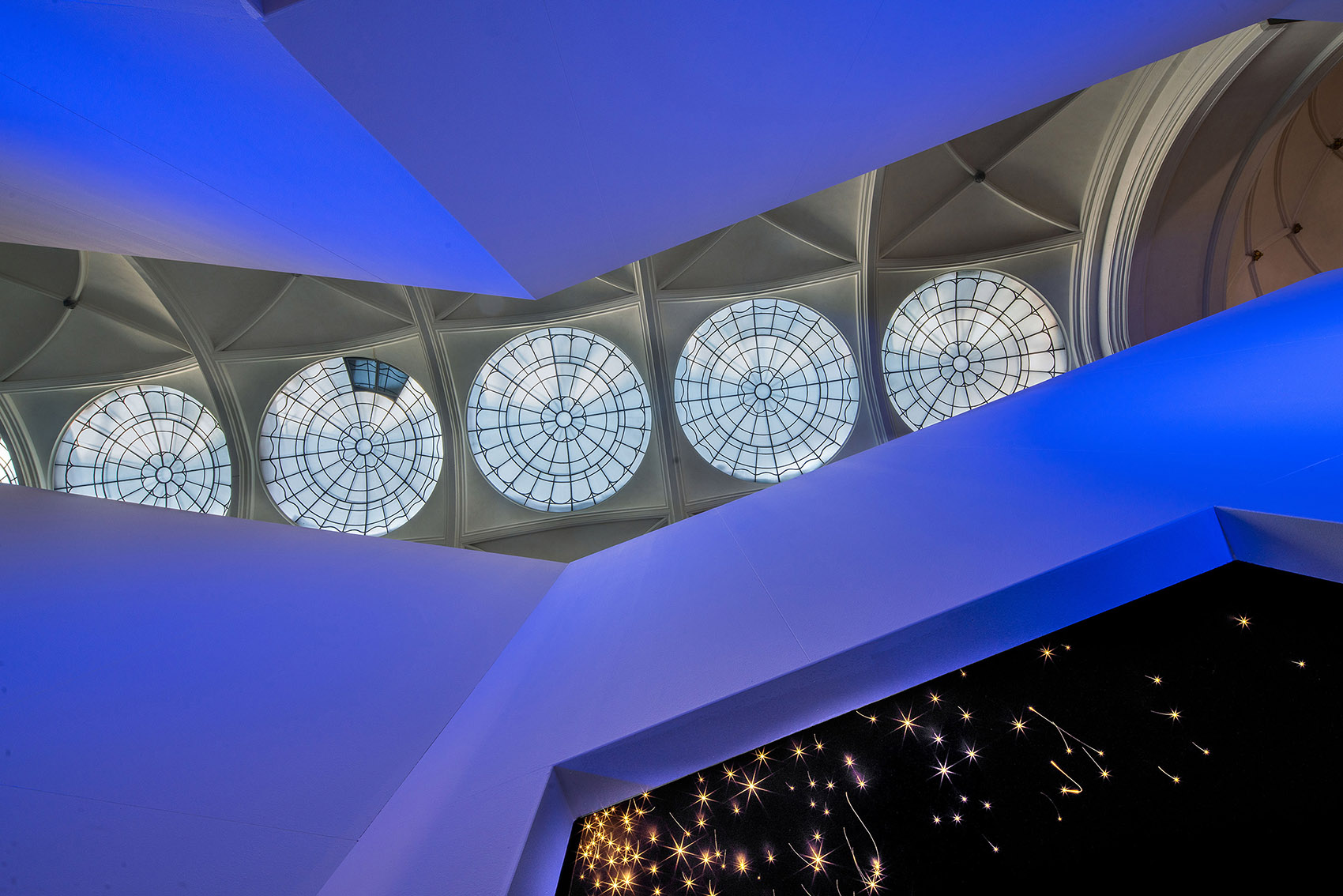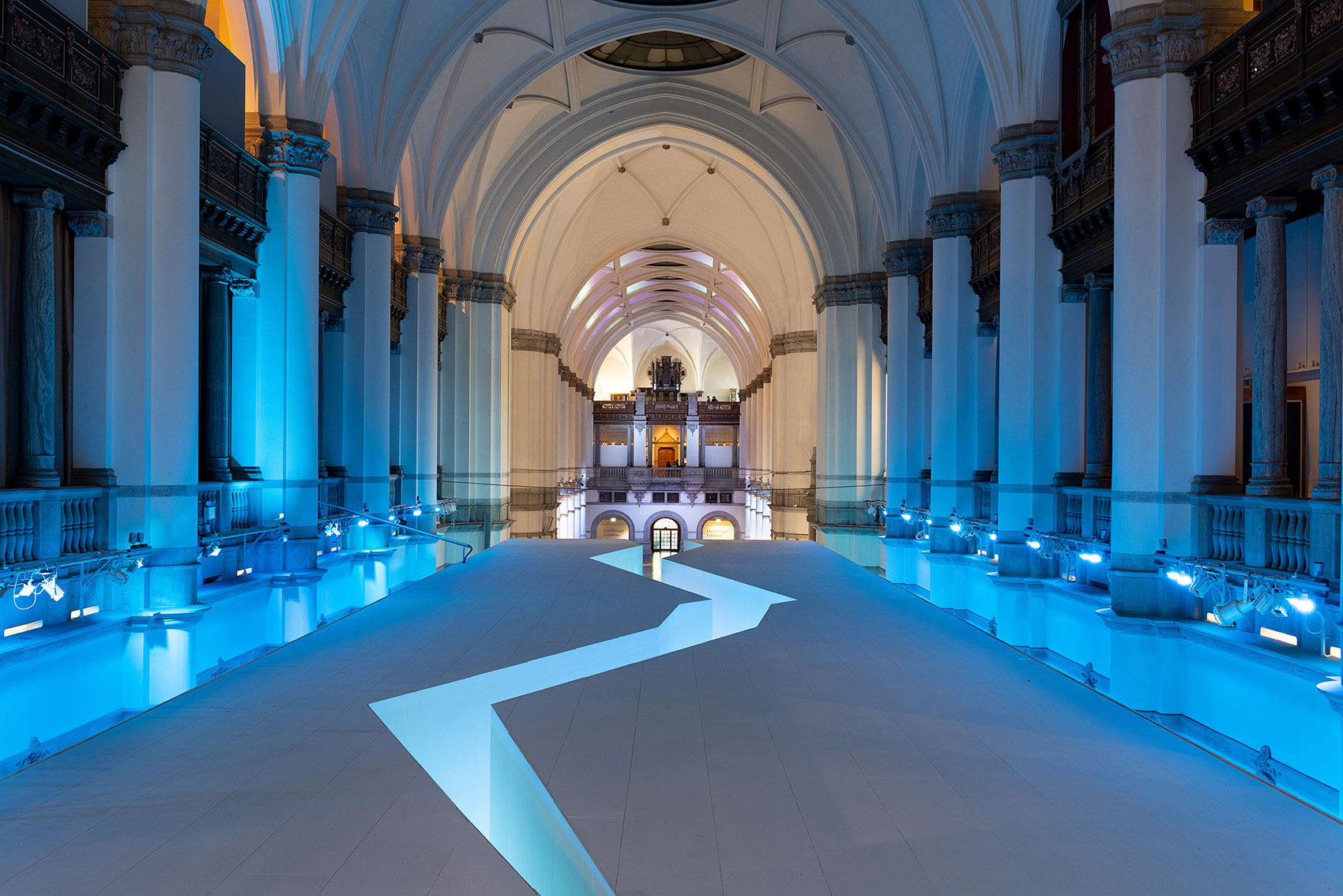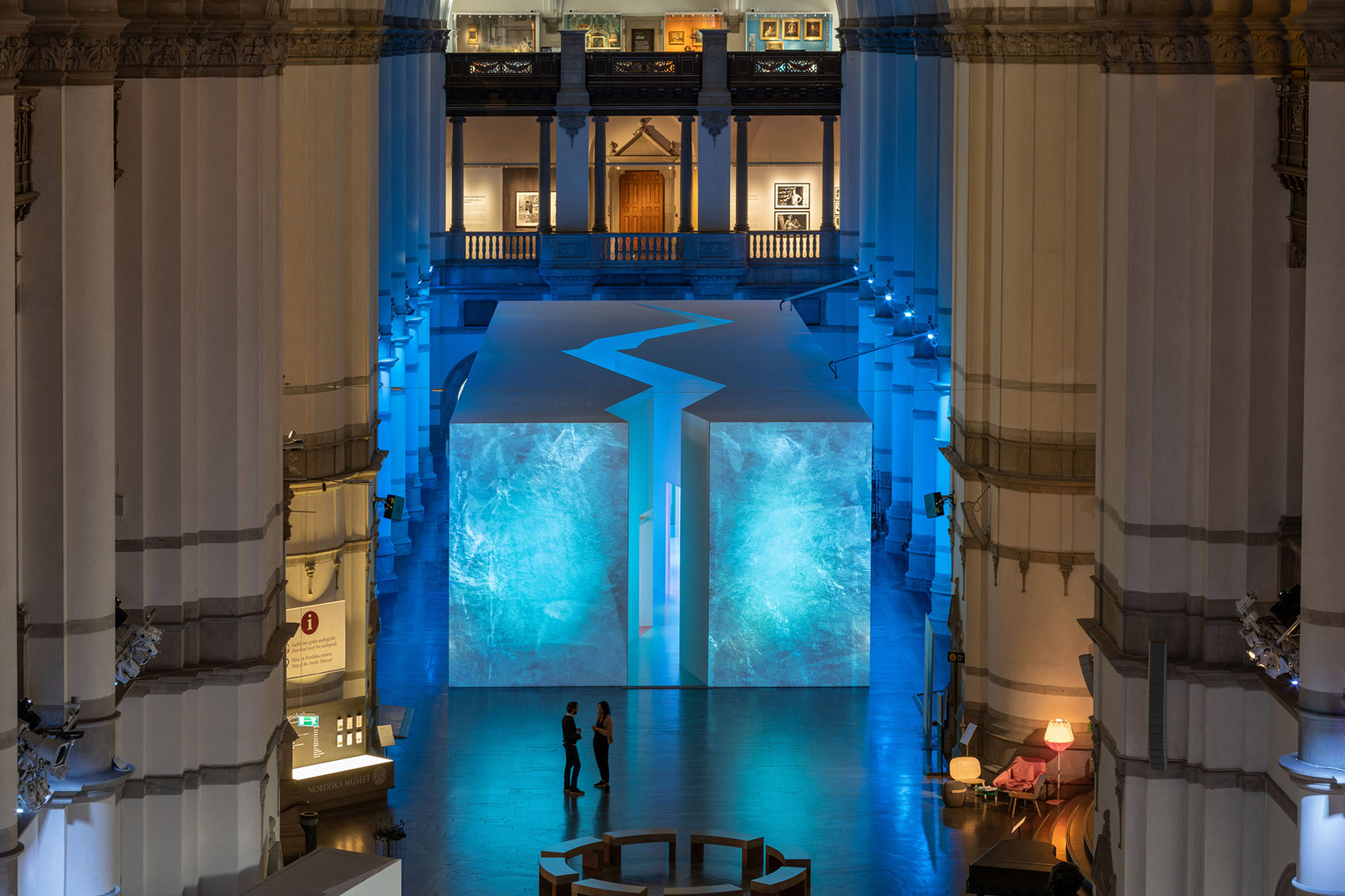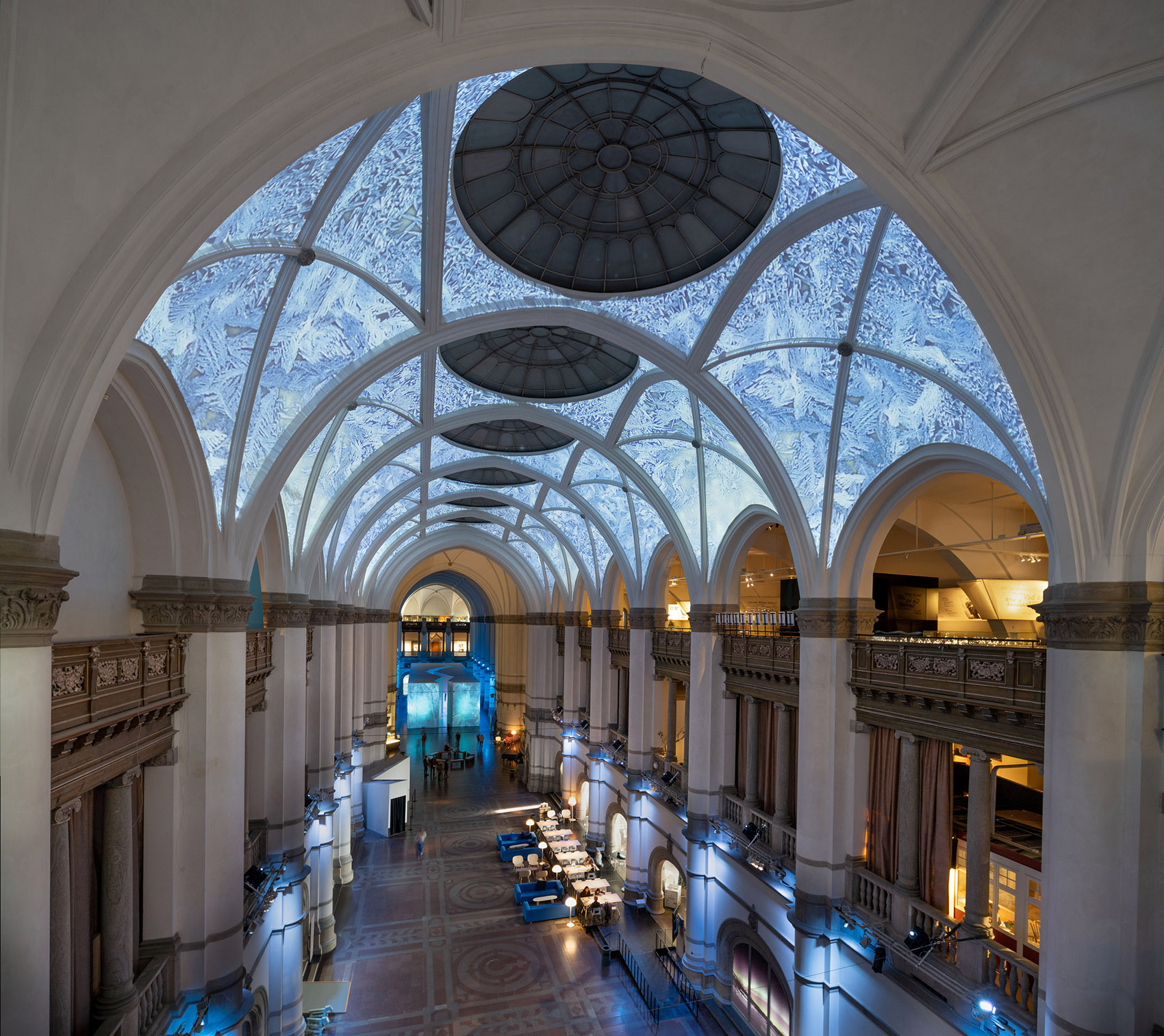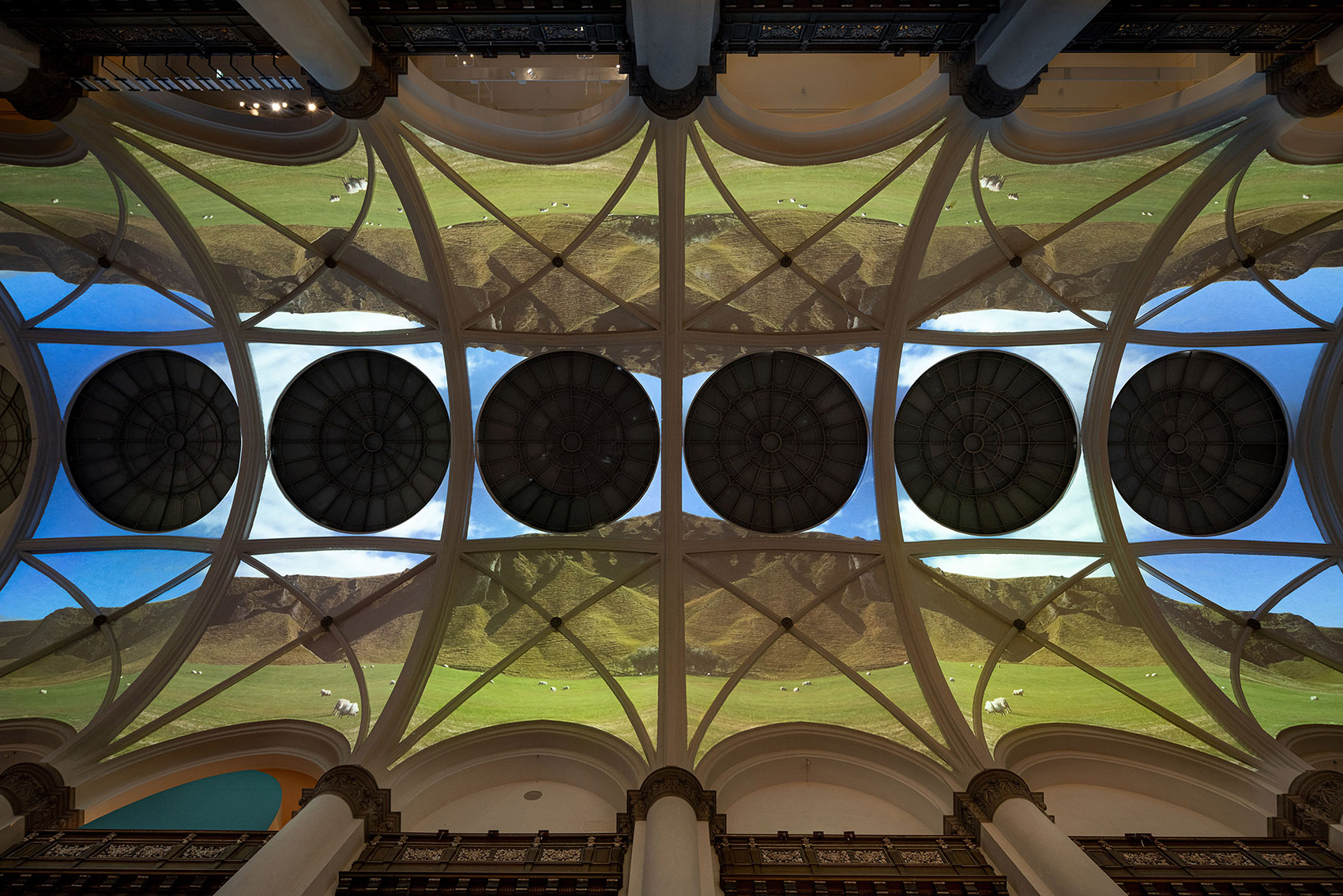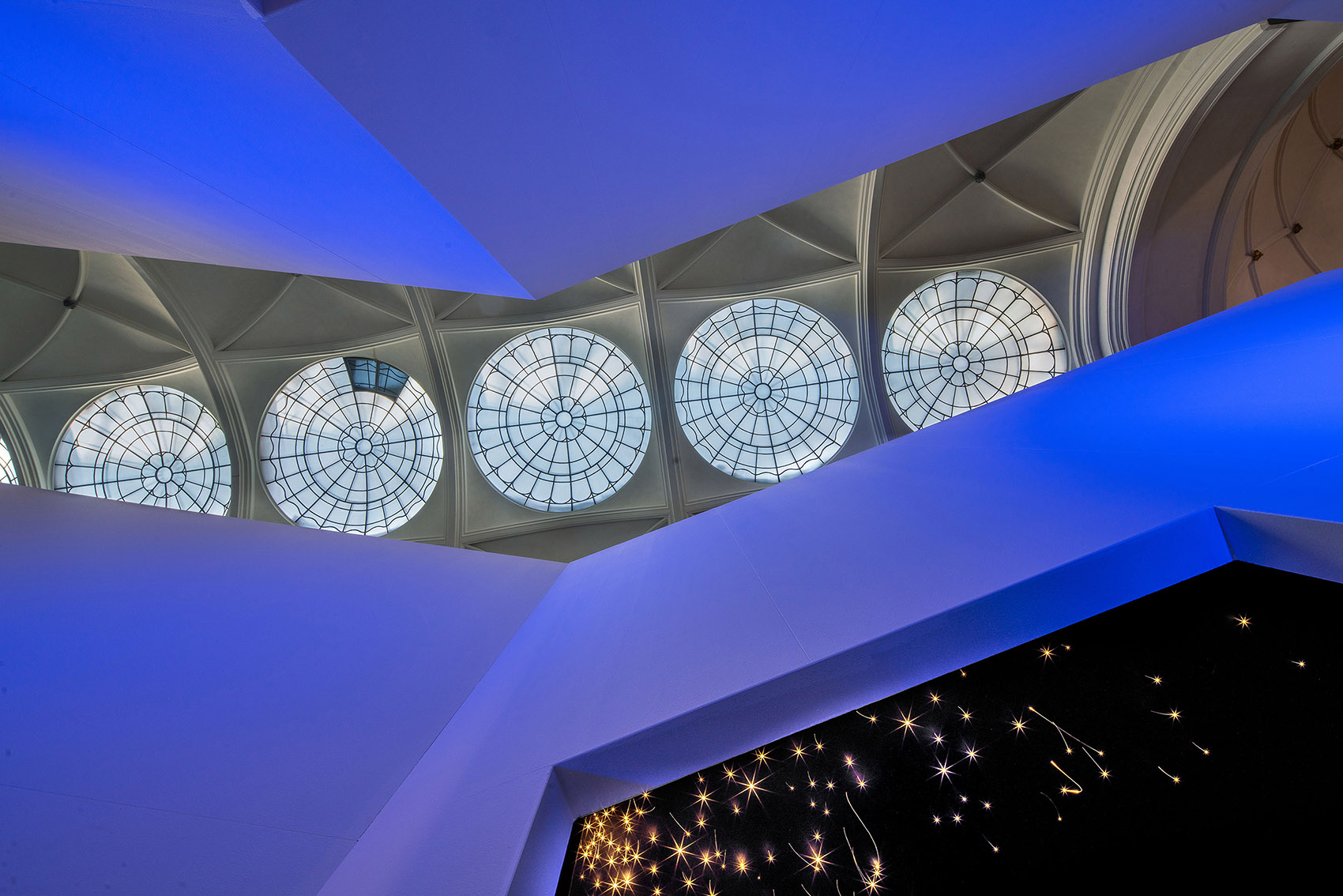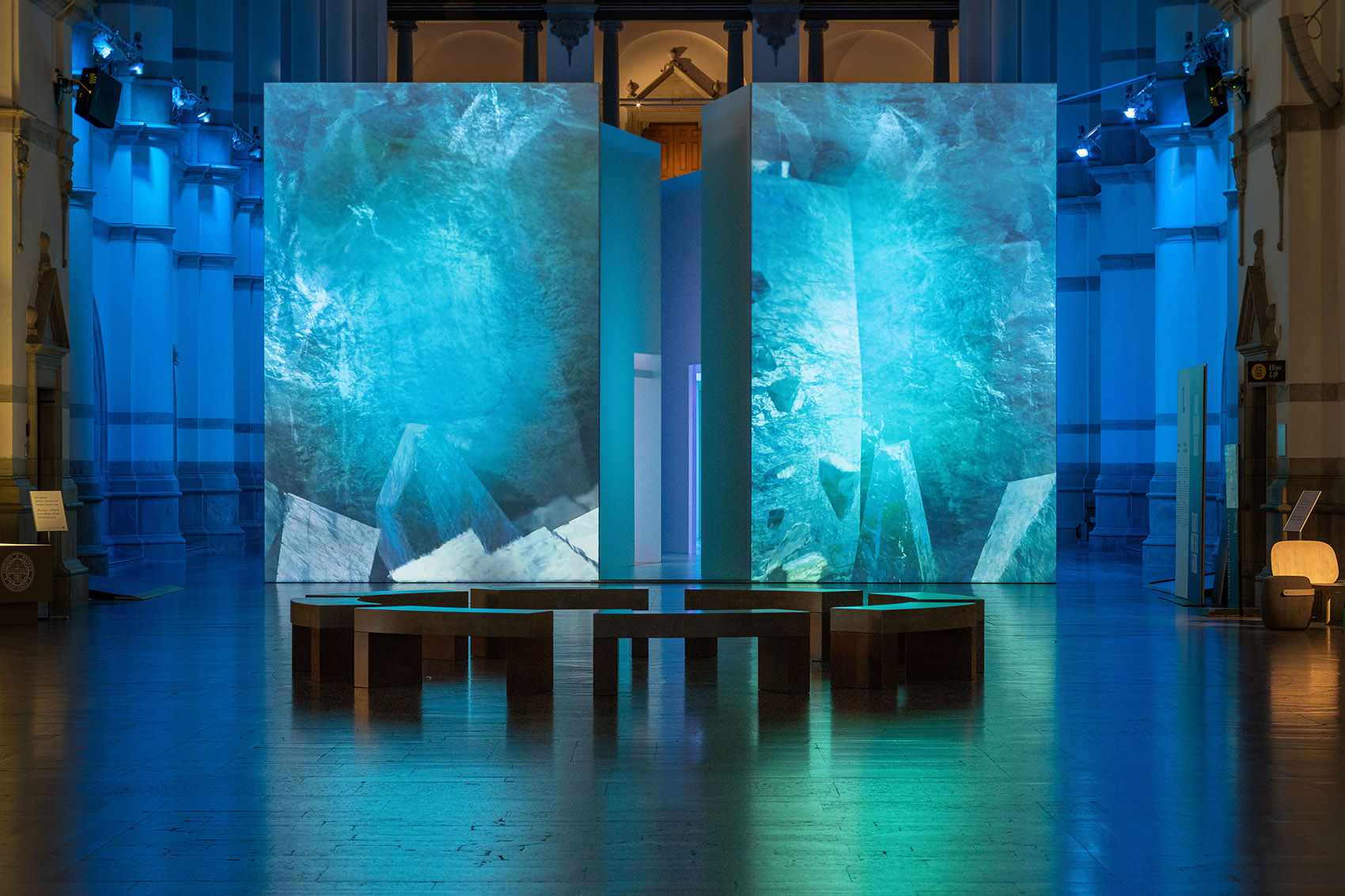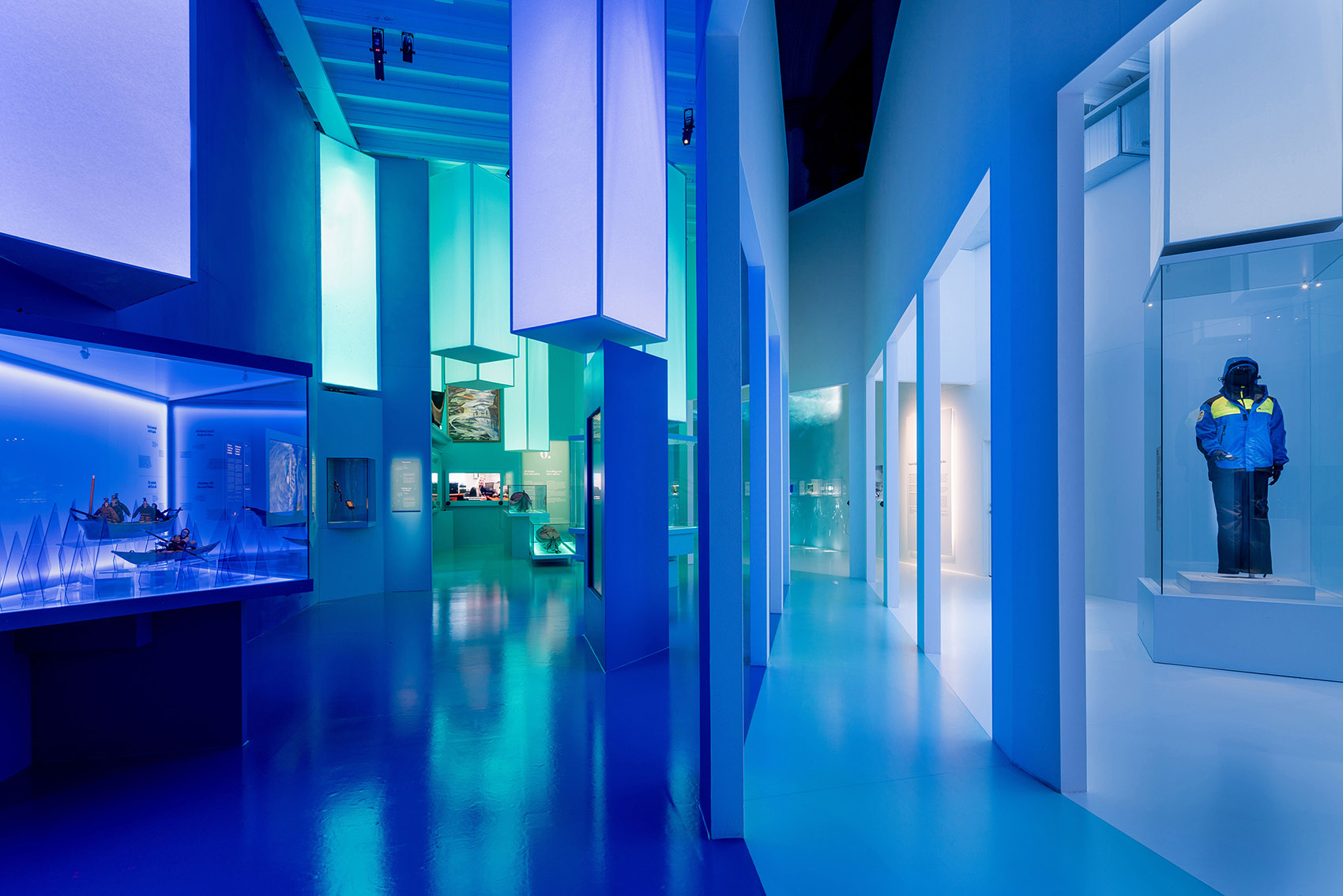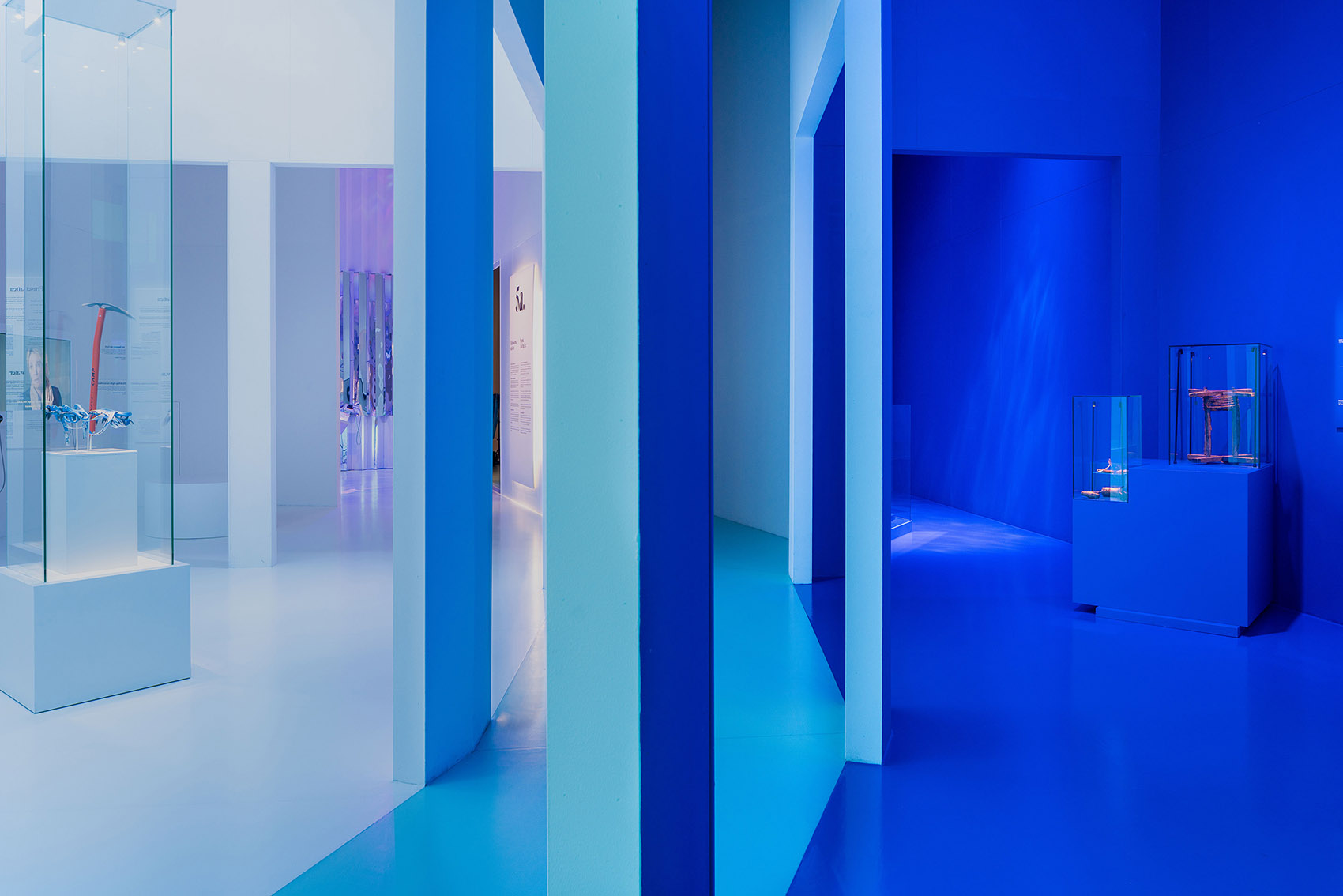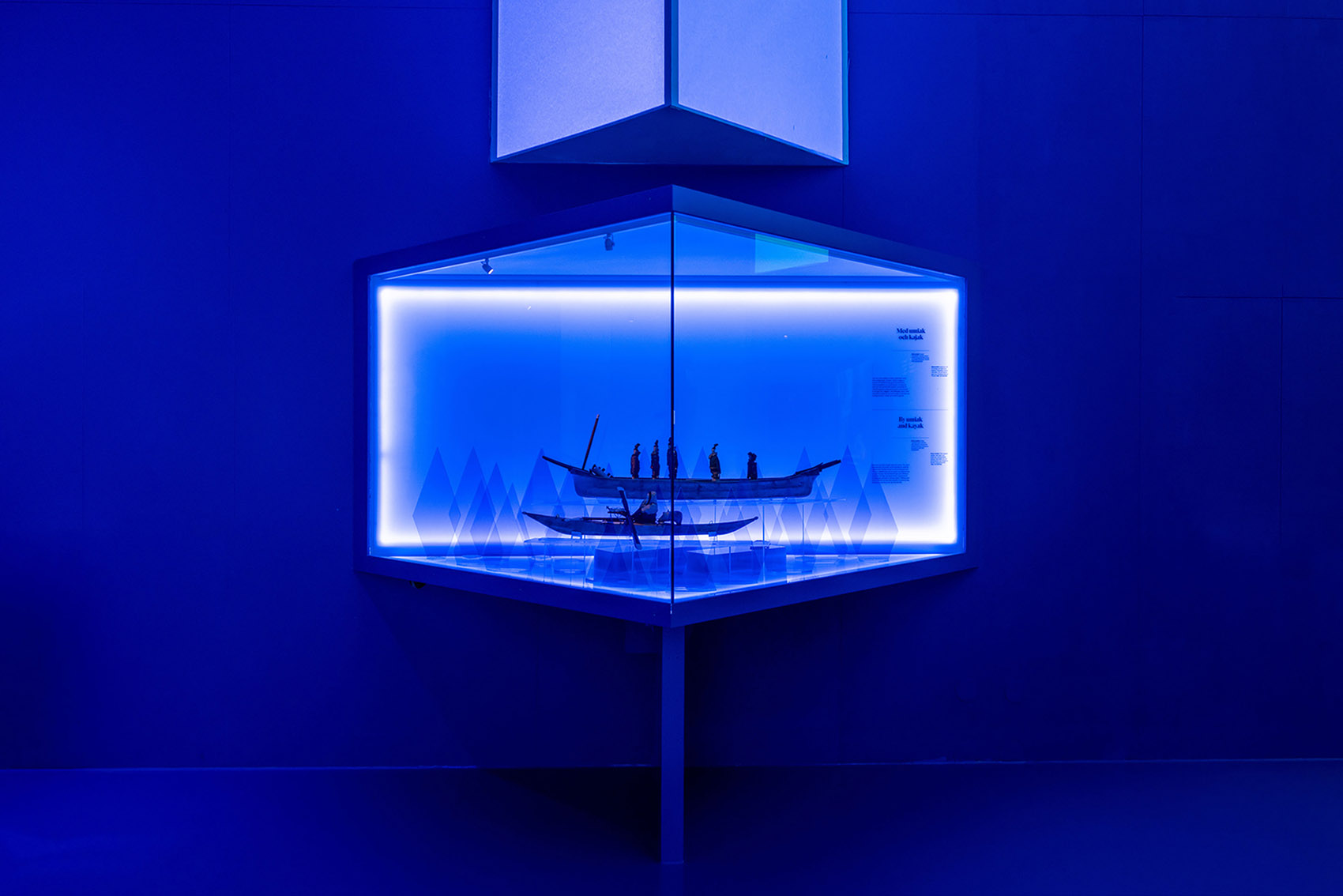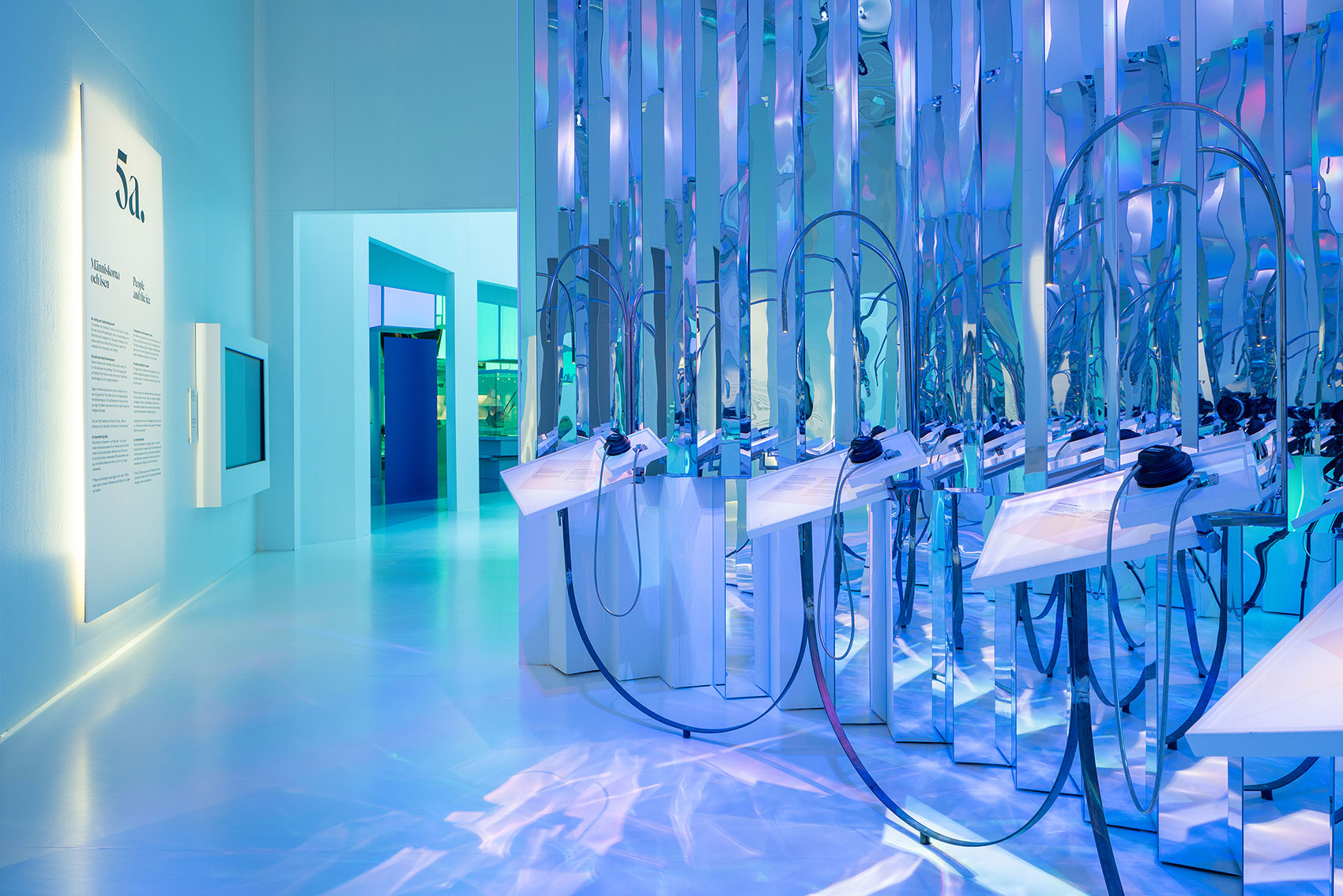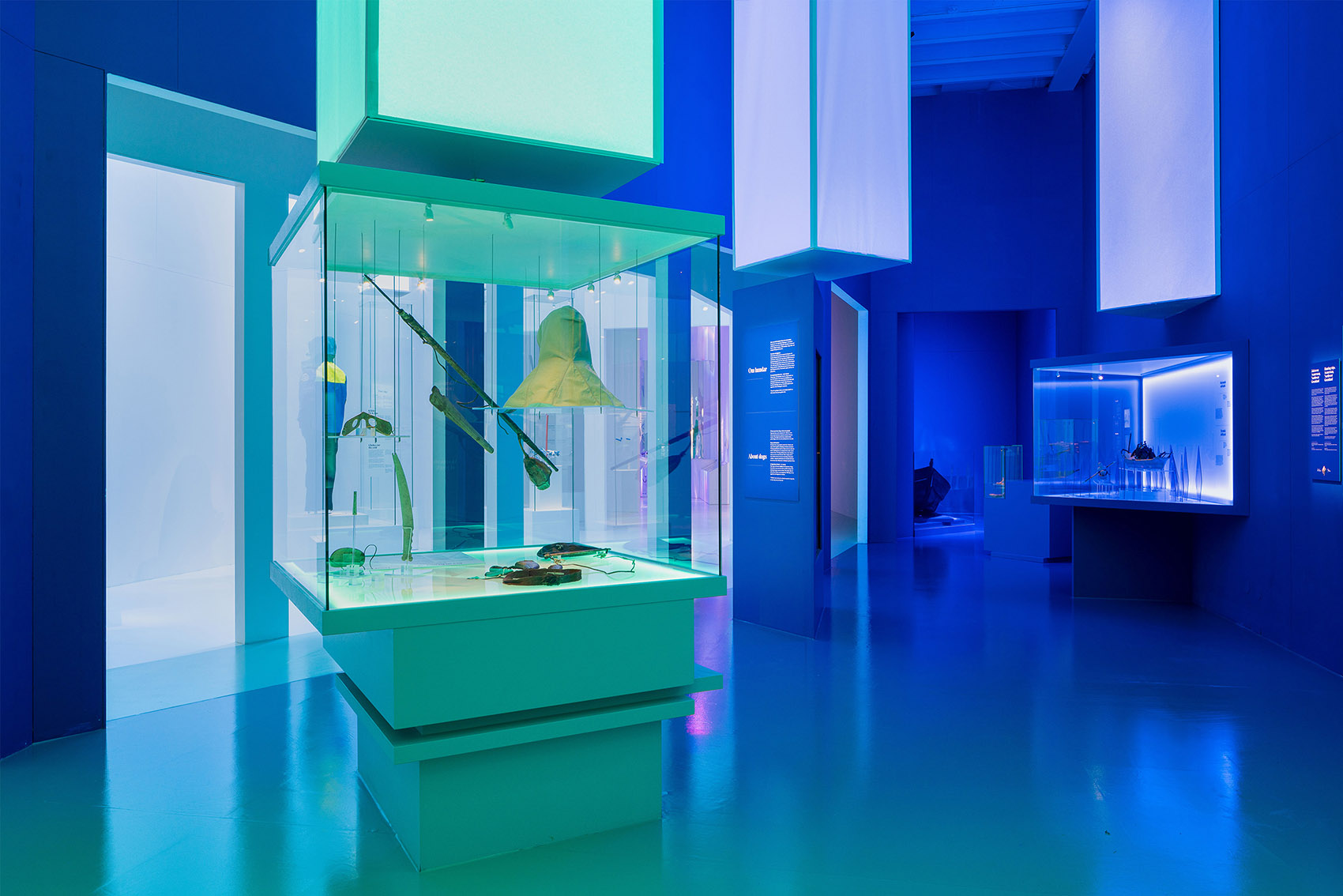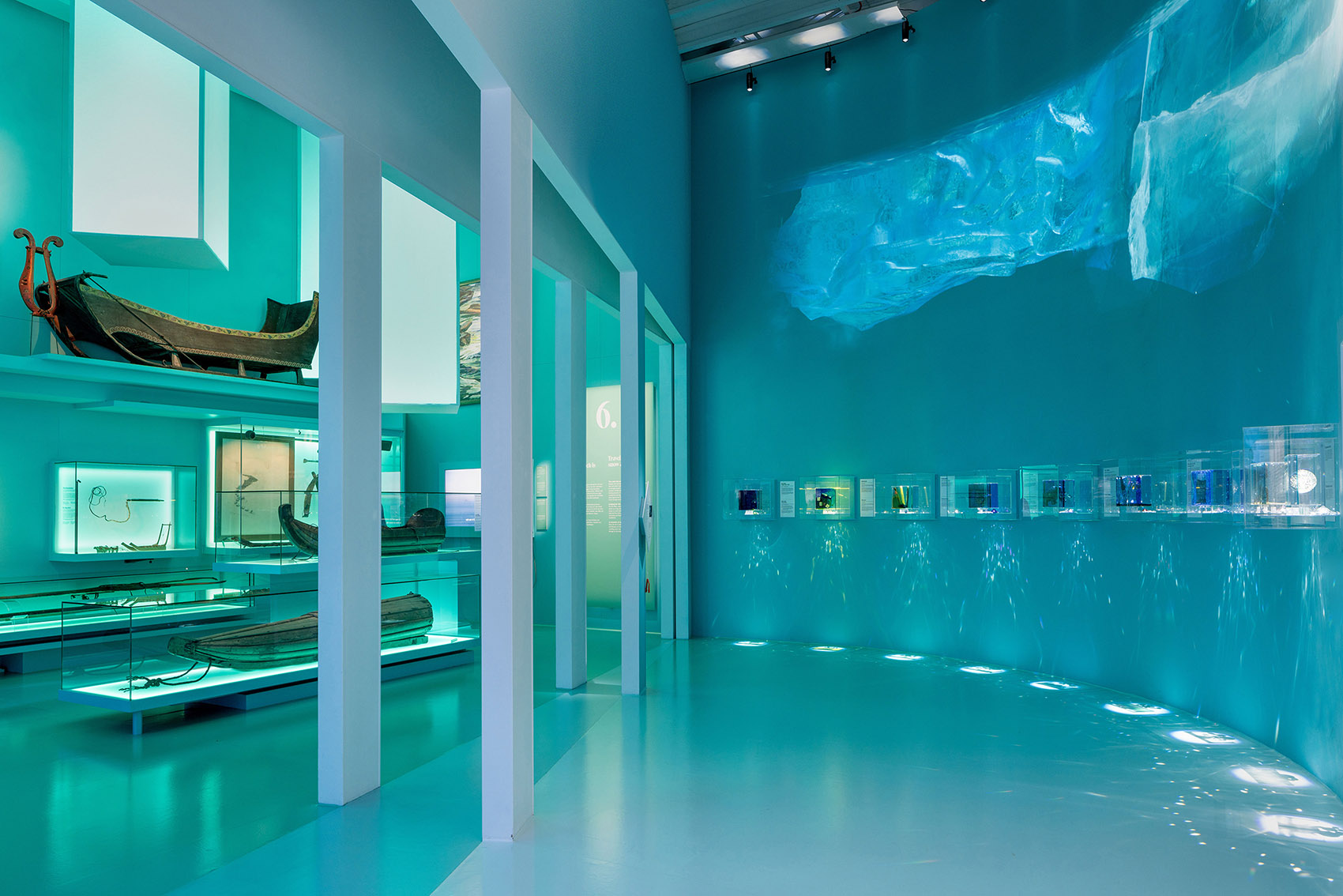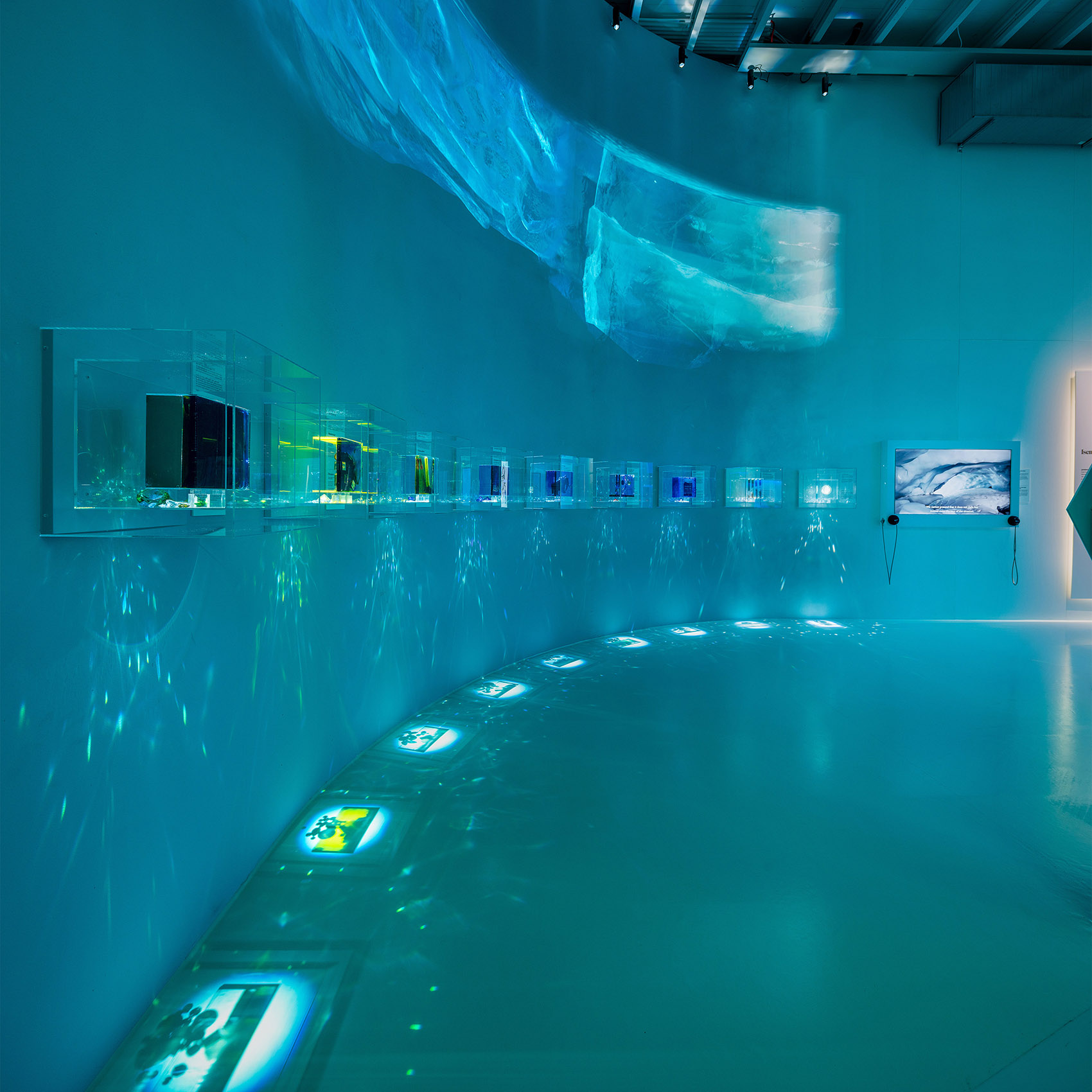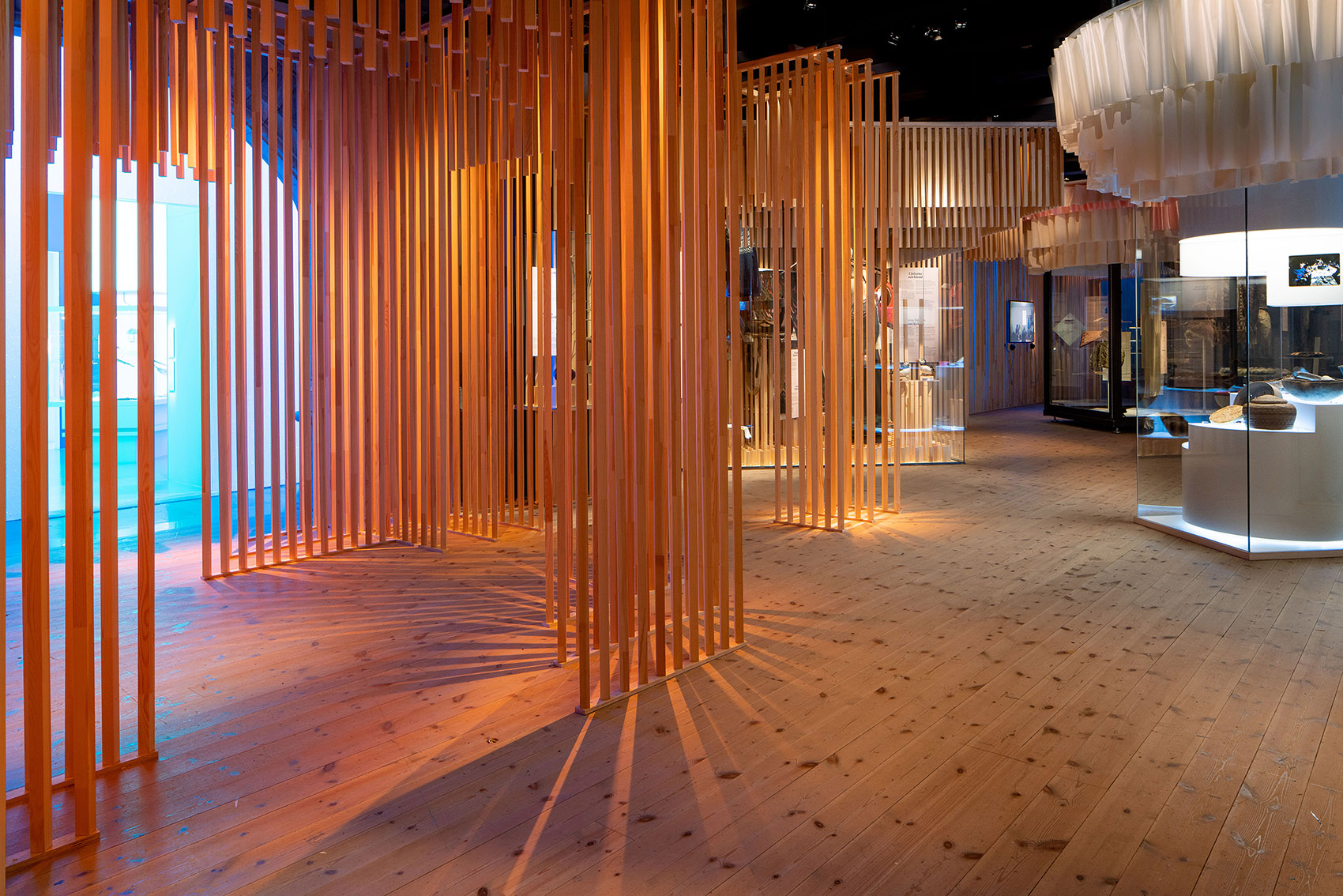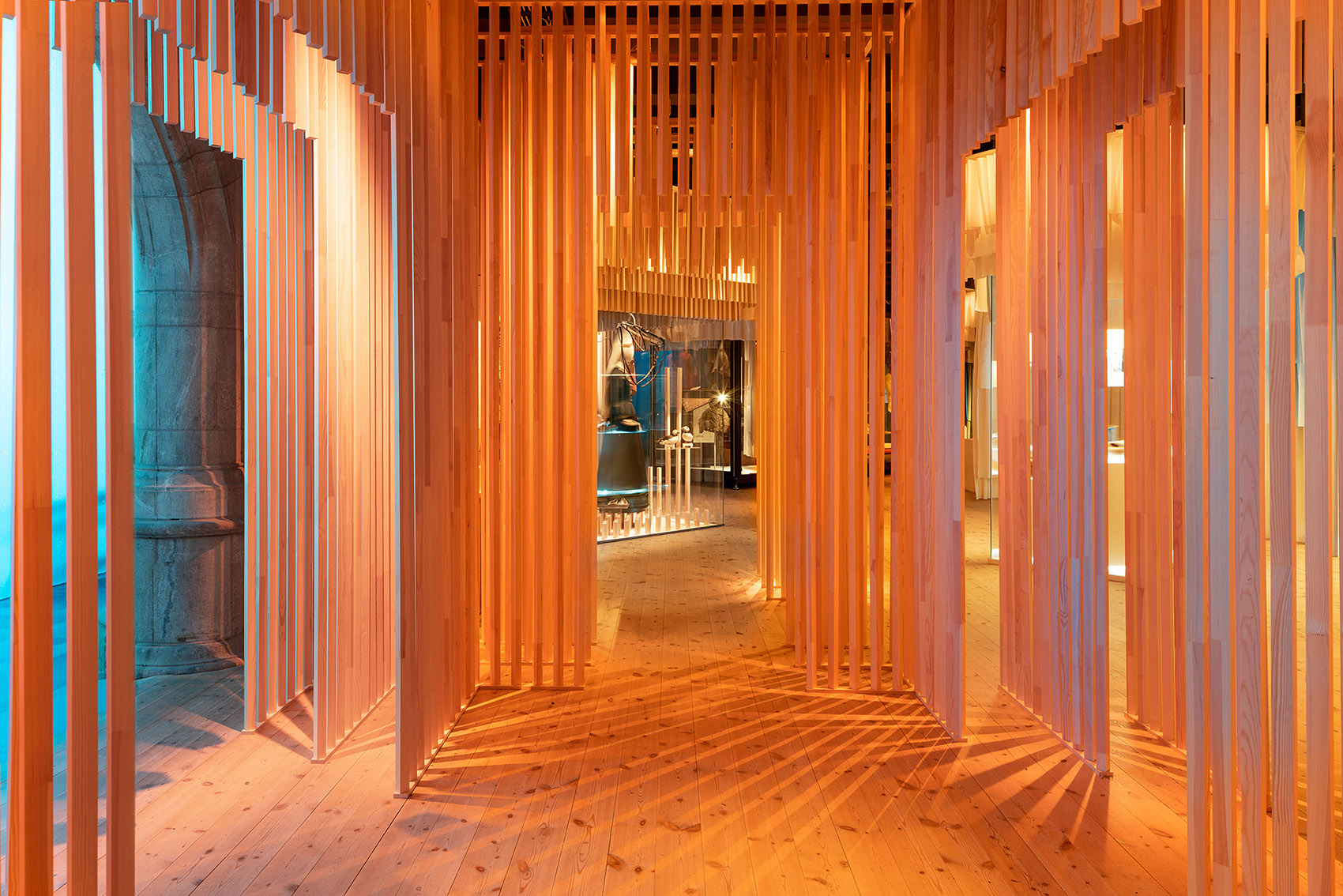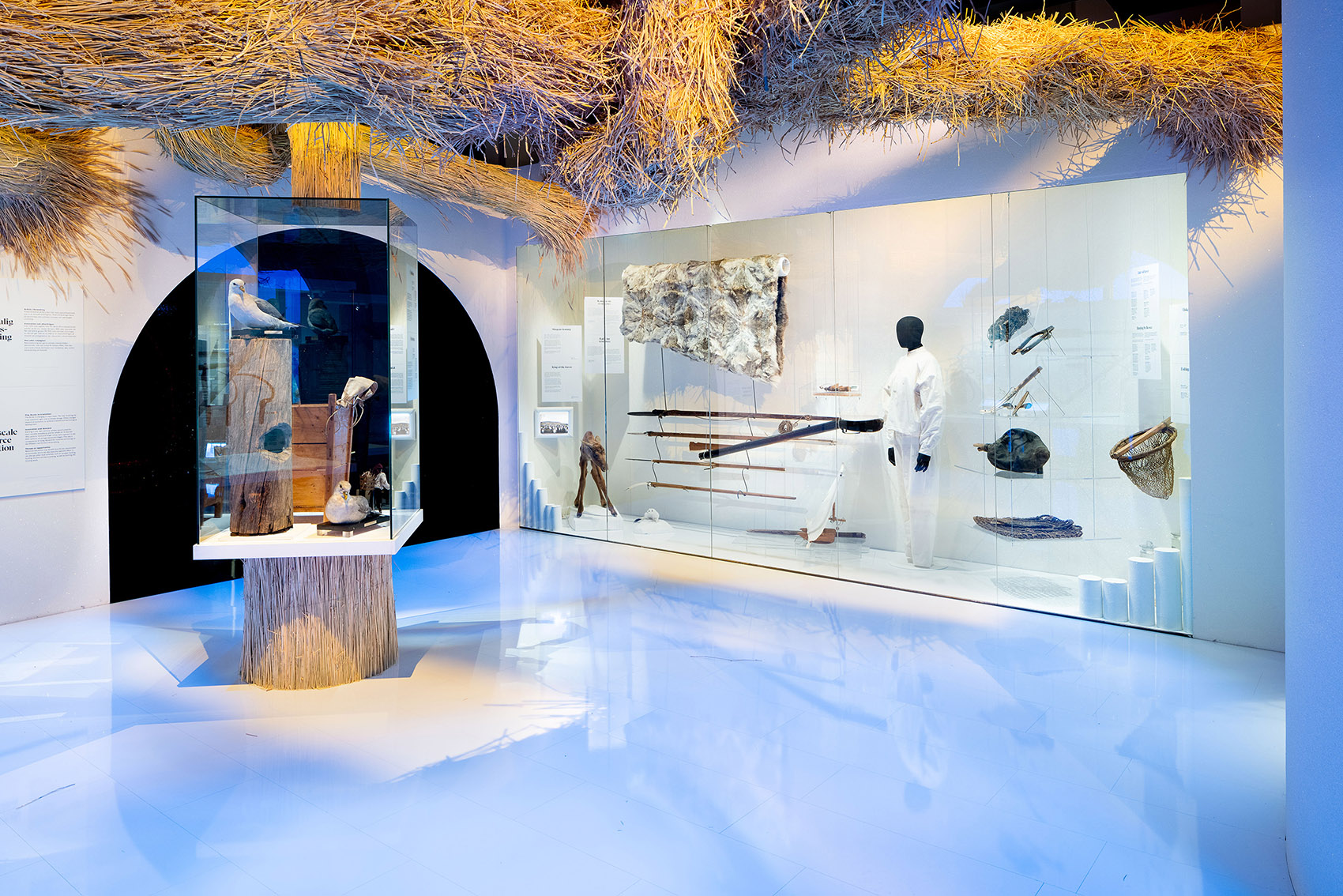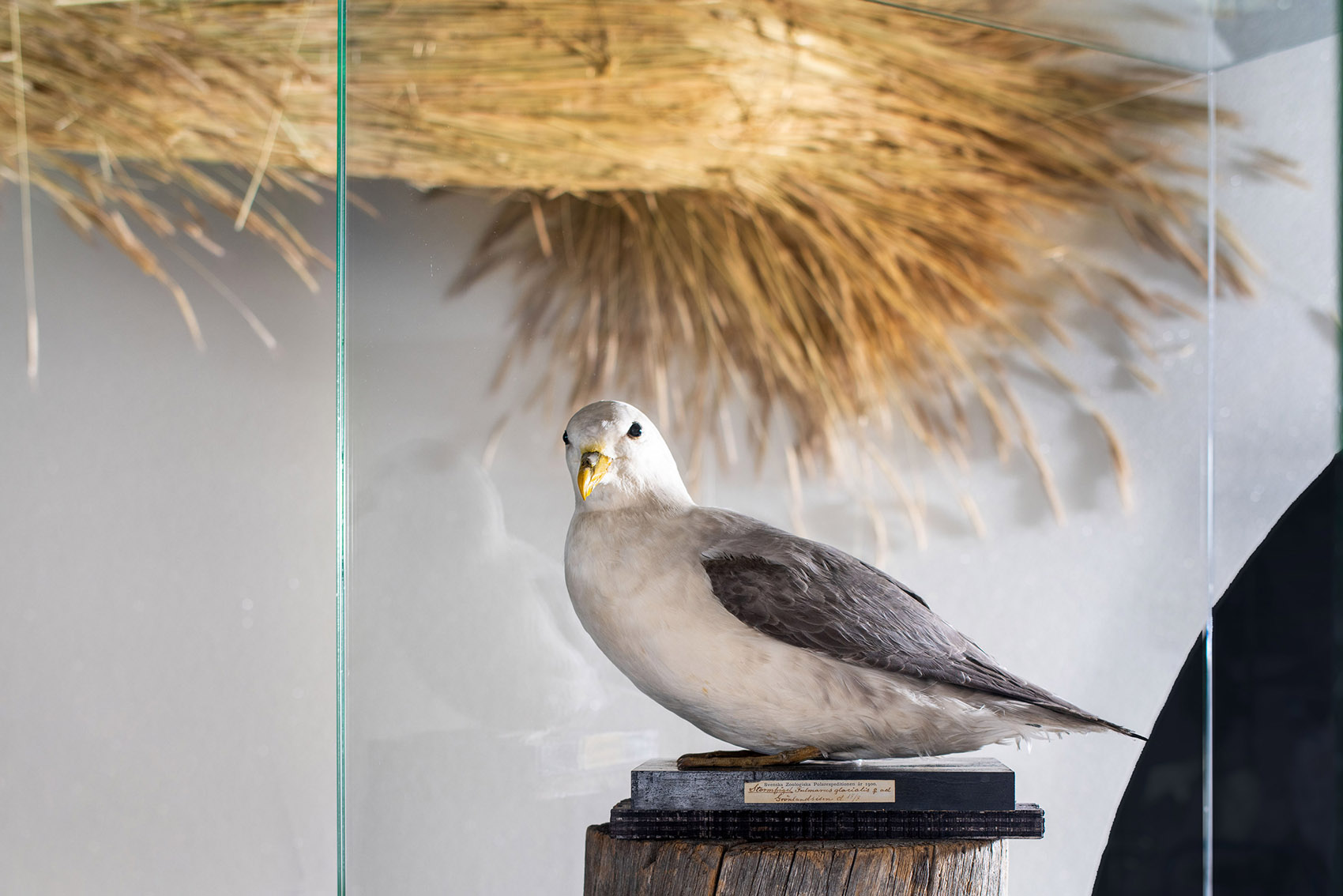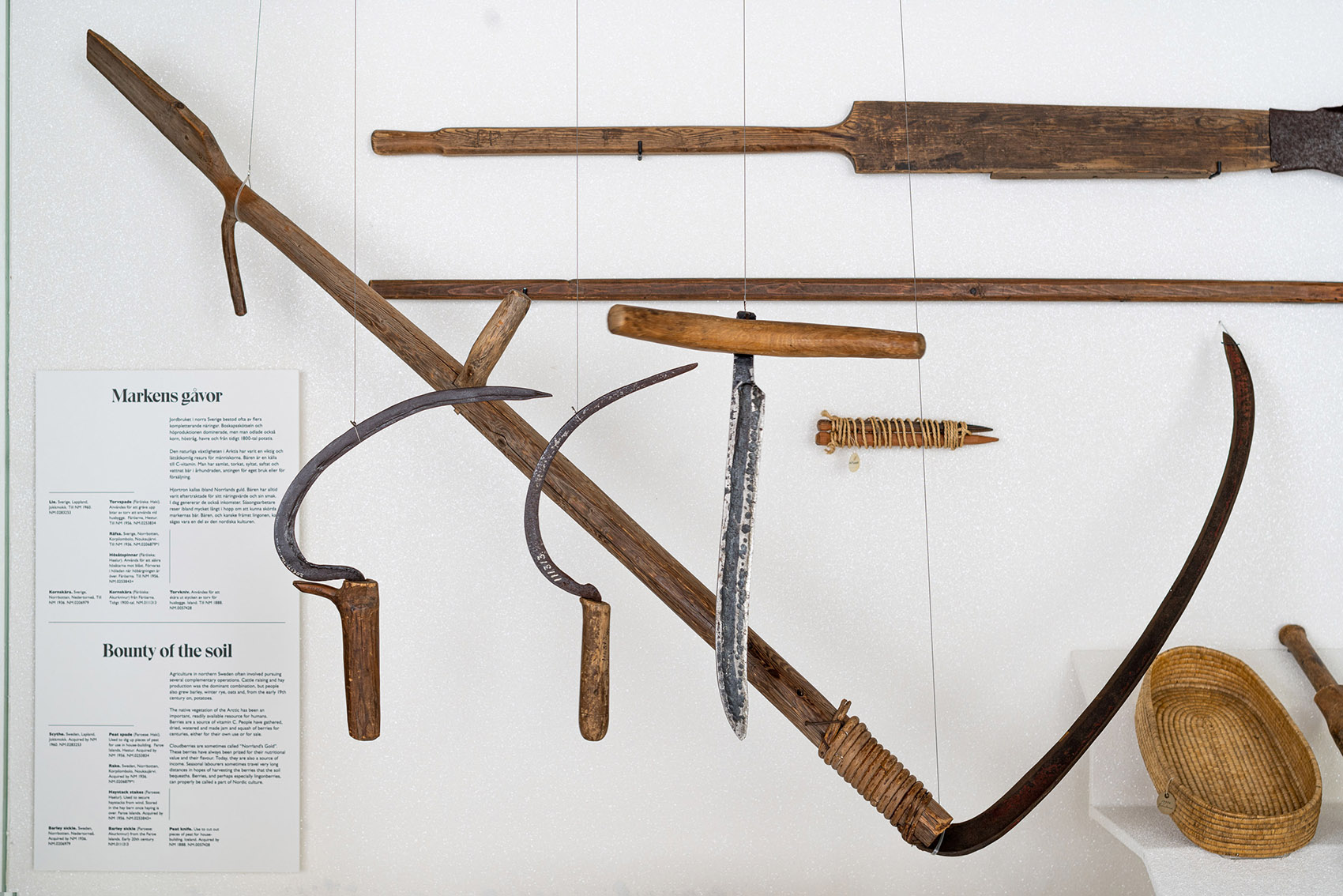北极星闪烁,子午线交汇,时区不复存在——这就是北极的起点,是四百万在冰河之中生活了上千年的人民的家园。北欧博物馆的大厅被用来展示北极地区的生活和不断变化的环境。在北极,当碰到冰正在融化的时候,游客们就能见证冰块、以及生活在世界上气候变化最显著地带之一的人们的历史和未来。
Under the bright light of the North Star, where meridians meet and time zones come to an end – this is where the Arctic begins. Home to four million people who have for thousands of years lived with the ice. The Nordic Museum’s Great Hall has been given over to the life and changing conditions of the Arctic region. In The Arctic – While the Ice Is Melting, visitors encounter the history and future of the ice, and the people that live in one of the regions of the world where climate change is most noticeable.
▼大厅的上层空间,the upper floor of the hall © Hendrik Zeitler
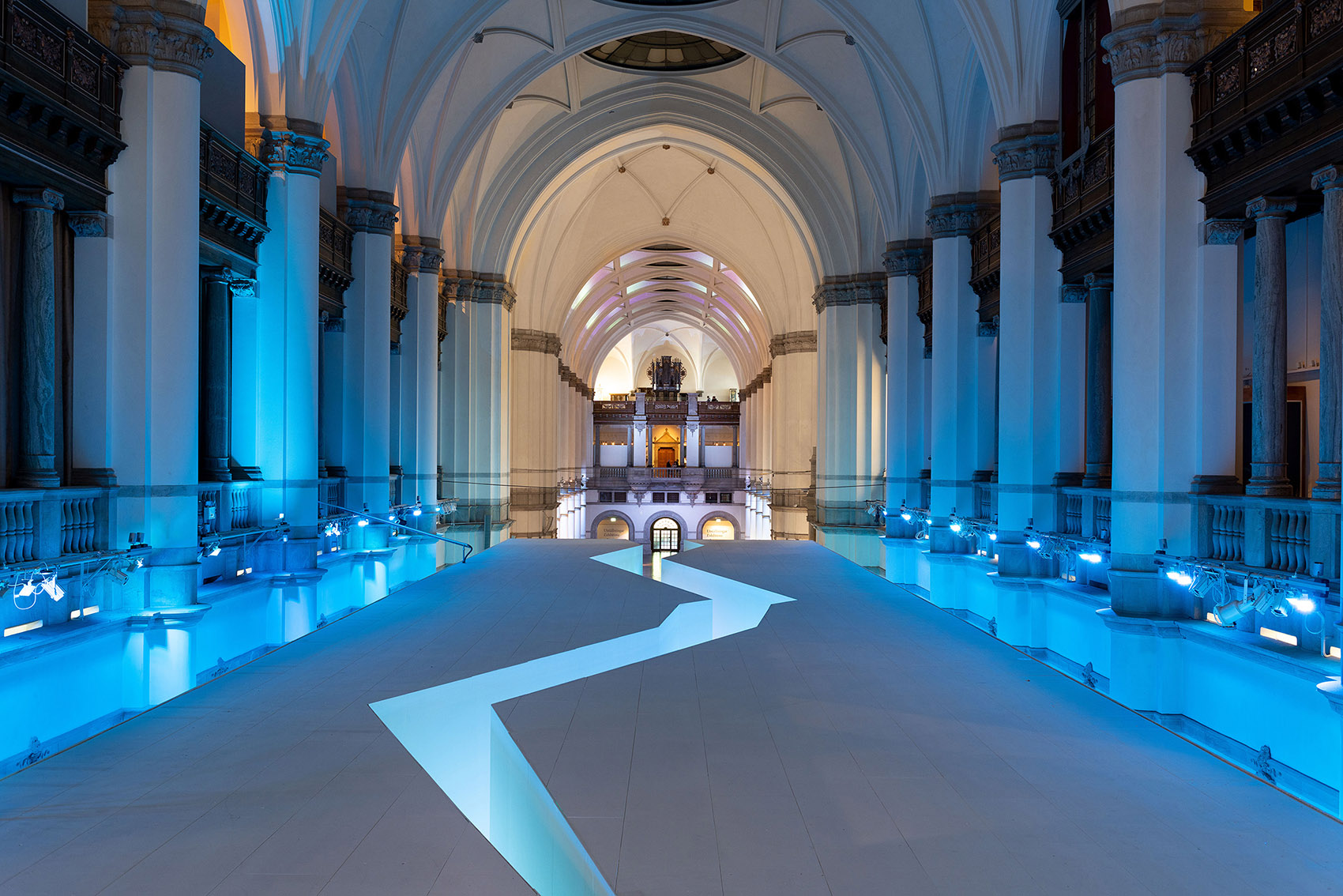
获奖设计师索菲亚·海德曼和塞尔日·马丁诺夫设计了这次盛大的展览。此次展览空间占地2000多平方米,是北欧博物馆、来自极地地区的40名研究人员和专家与展览设计者密切合作的结果。“这是我们设计的最重要的展览之一。”索菲亚·海德曼说,“气候变化是一个关系到所有人的重大问题。在本次设计中,我们希望游客在获得一种强大的沉浸式体验的同时,也觉得人们必须一起行动起来了。”
Award-winning designers Sofia Hedman and Serge Martynov of MUSEEA designed this grand exhibition. Occupying over 2,000 square meters, the exhibition is a result of a close collaboration between the Nordic Museum, 40 researchers and experts from around the polar area and the exhibition designers. “This is one of the most important exhibitions that we have designed”, says Sofia Hedman. “Climate change is a critical issue that concerns us all. With our design, we want the visitor to have a powerful and immersive experience, but at the same time feel that we must all come together and act now.”
▼博物馆大厅,museum hall © Hendrik Zeitler
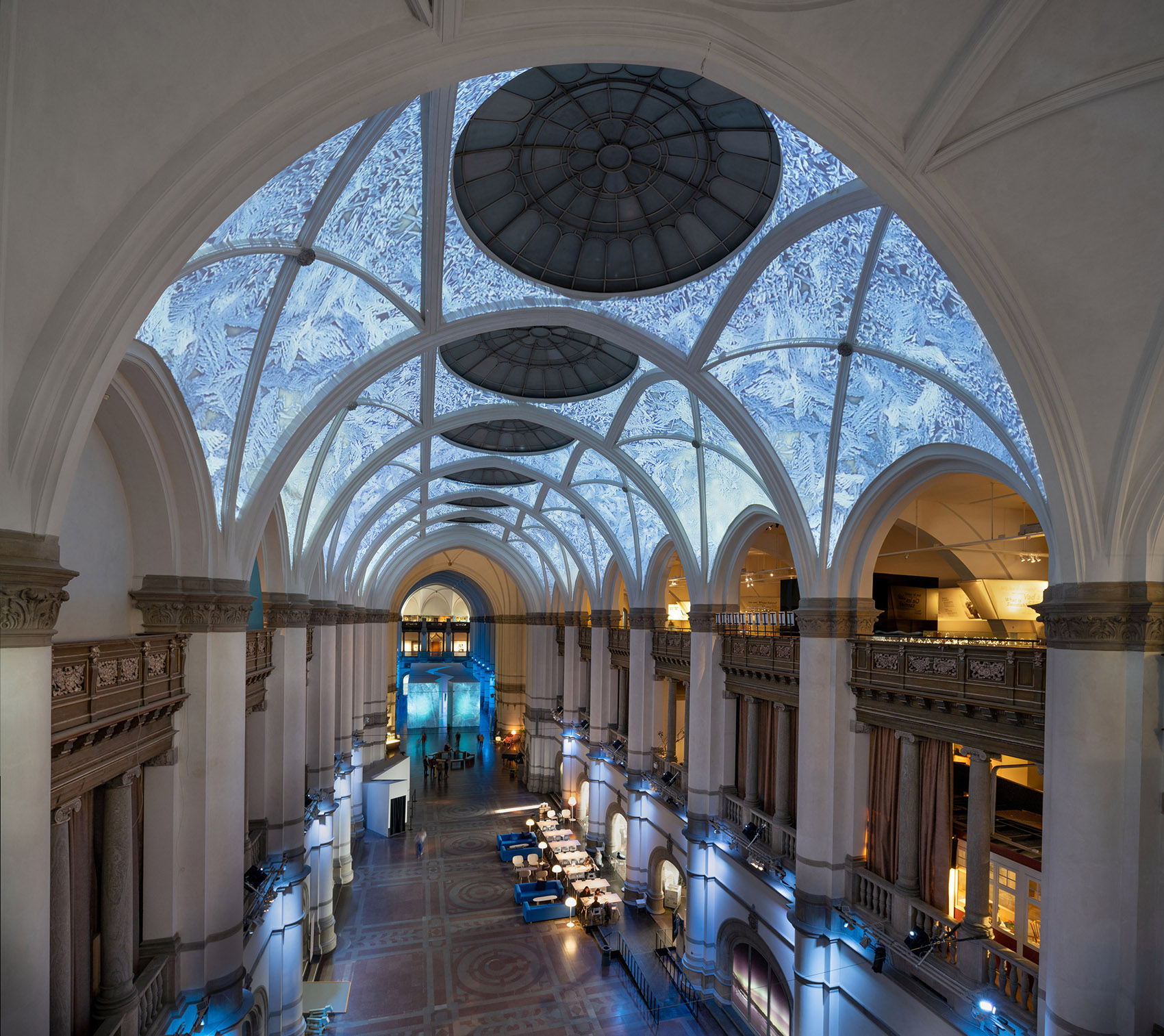
裂缝在许多方面影响着北极地区。随着温度升高、冰块融化,裂缝也就随之出现。这些裂缝会导致严重的冰山崩裂、房屋损毁淹没、动物难以觅食。裂缝的产生,也同时象征着自然界中人与历史传统的分裂。在展览现场迎接观众的是每隔一段时间就会融化的巨型冰块。它被一条巨大的裂缝分开,游客可以经由这条裂缝跟随融水进入展览。
Cracks affect the Arctic in many ways. As temperatures rise, ice melts, and cracks occur. Cracks cause huge icebergs to break loose. Cracks cause houses to deteriorate and animals to struggle to find food. Cracks also have a symbolic meaning. They arise in nature between people and traditions. The visitor is met by a monumental block of ice that periodically calves. It is split by a giant crack, through which, visitors can follow the meltwater into the exhibition.
▼巨型冰块展厅,giant ice exhibition hall © Hendrik Zeitler
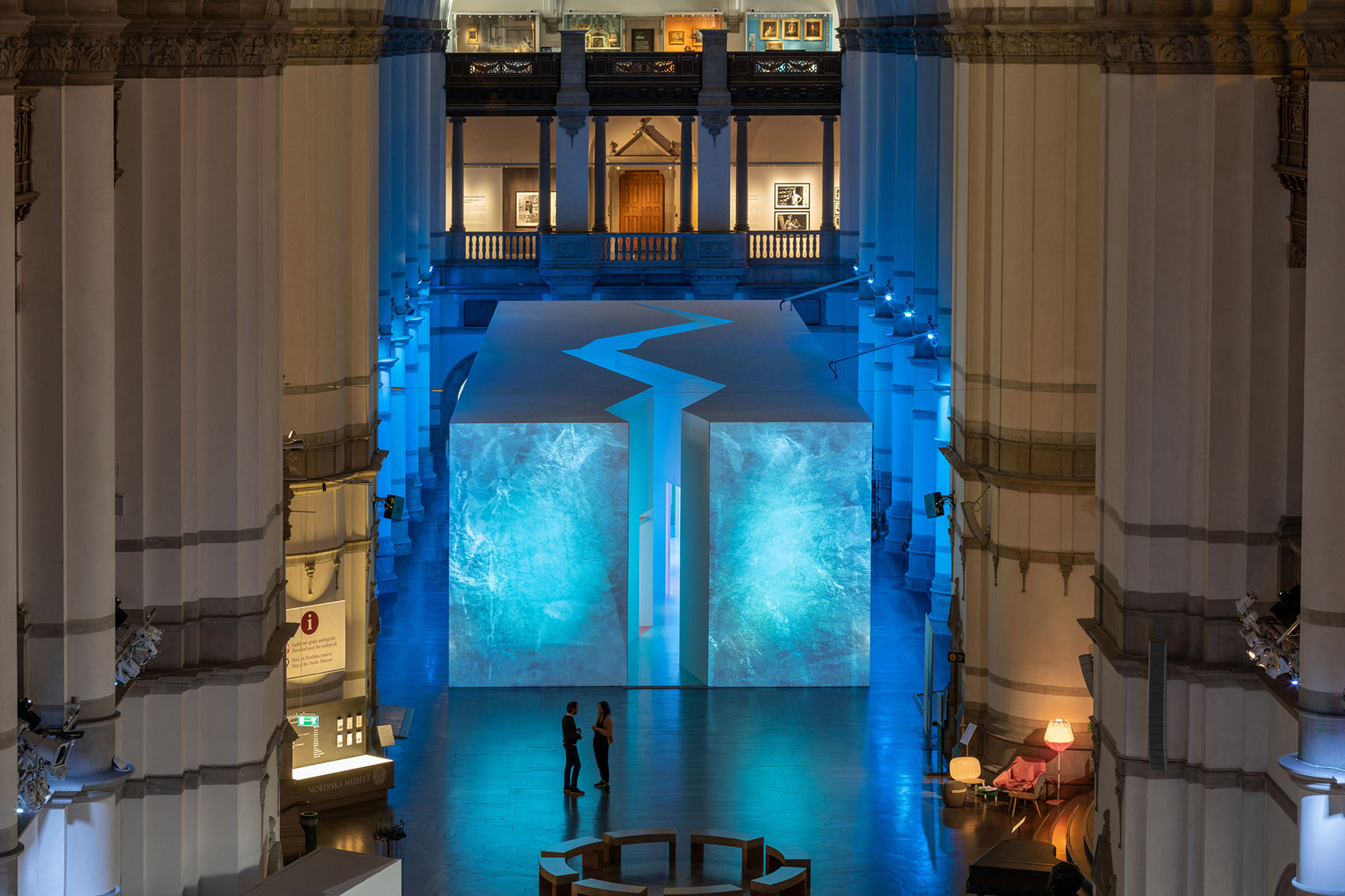
在冰块内部,游客可以体验身处北极的感觉。物品、账目、电影、幻灯片、网络摄像机和艺术一起,将现在与过去、科学与神话交织在一起,构成一个关于北极的历史和未来、以及当地人民日常生活的诗意而丰富多彩的故事。该展览是由为了在极端气候中生存而衍生出的多种极具创造力的方式来推动的。
▼裂缝展厅入口,crack gallery entrance © Hendrik Zeitler
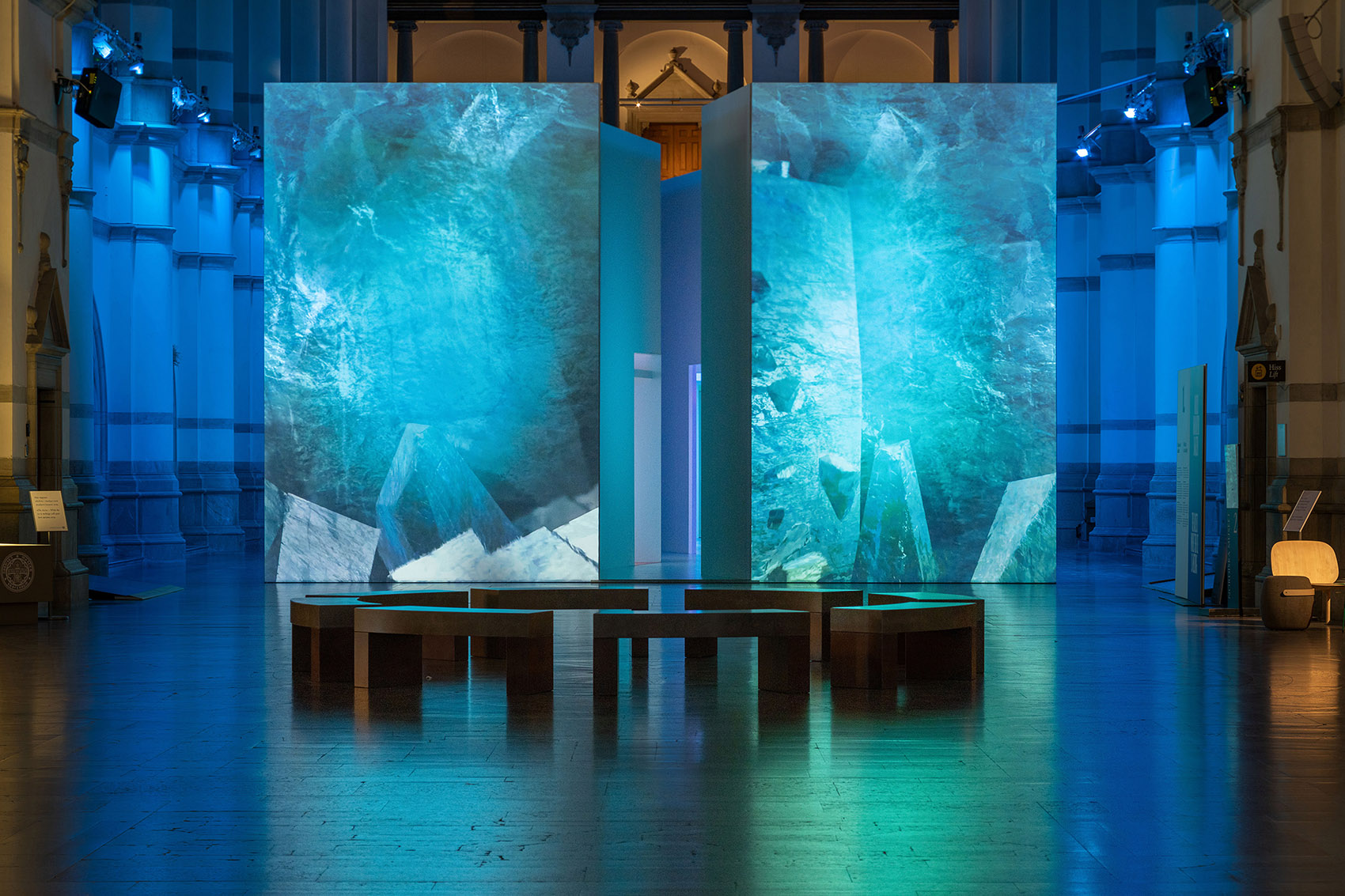
Inside the ice block, the visitor experiences the Arctic. Objects, accounts, films, slideshows, webcams and art weave together present and past, science and mythology, into a poetic and multifaceted story about the history and future of ice and the everyday lives of the people in the Arctic. The exhibition is driven forward by endless and highly inventive ways to survive in the extreme climate.
▼数字展览部分,digital exhibition part © Hendrik Zeitler

▼讲述北极历史与未来的媒介,medium for telling the history and future of the arctic © Hendrik Zeitler
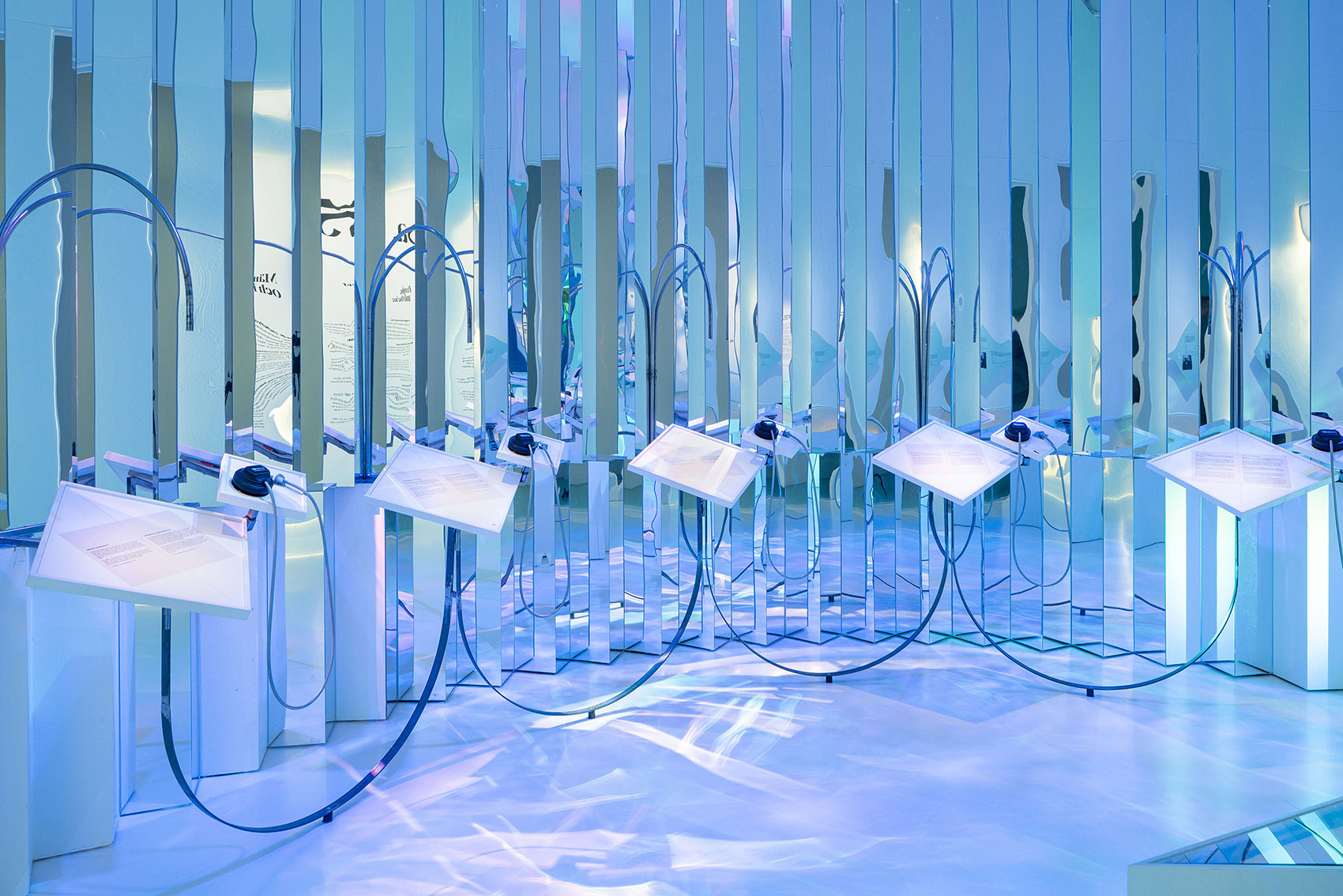
游客从坚硬的白色冰块,逐渐移动到浅绿色和蓝色的融水区,最终抵达完全融化成深蓝色的海洋。传统生活与现代生活之间出现了裂痕。想要继续从冰路穿行已然不可能,人们必须寻找新的方法。而船和直升机的普遍使用,逐渐取代了步行、雪橇和滑板车。
The visitor moves from hard white ice, gradually transforming into light green and blue meltwater and eventually melting entirely into the dark deep blue sea. Cracks occur between traditional and modern life. It impossible to reach the ice roads, people must find new ways. Instead of walking, or using sleighs and scooters, boats and helicopters become increasingly common.
▼从白色展厅过渡到浅蓝色展厅,from the white exhibition hall to the light blue exhibition hall © Hendrik Zeitler
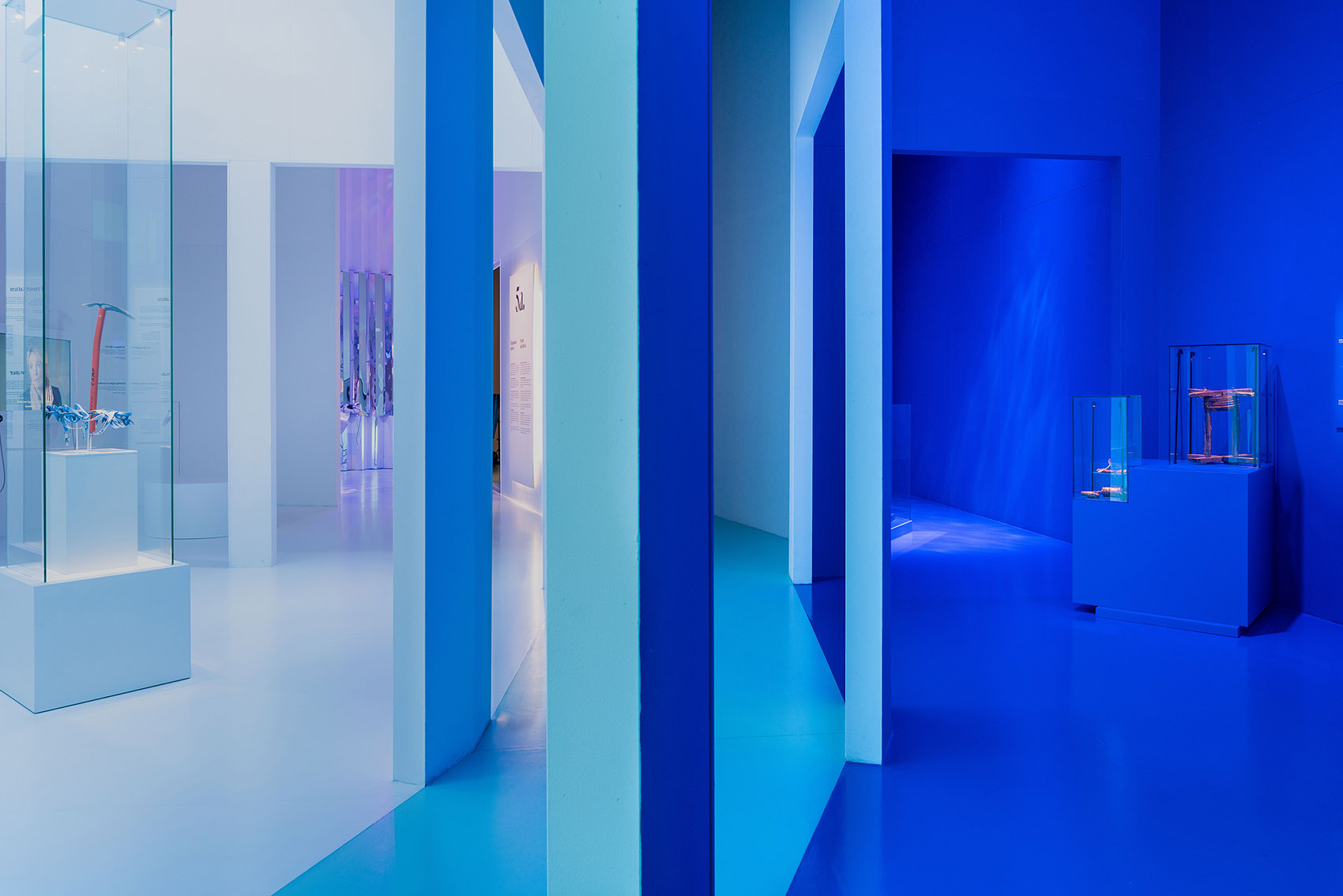
▼从浅蓝色展厅看向浅绿色区域,from the light blue exhibition hall to the light green area © Hendrik Zeitler
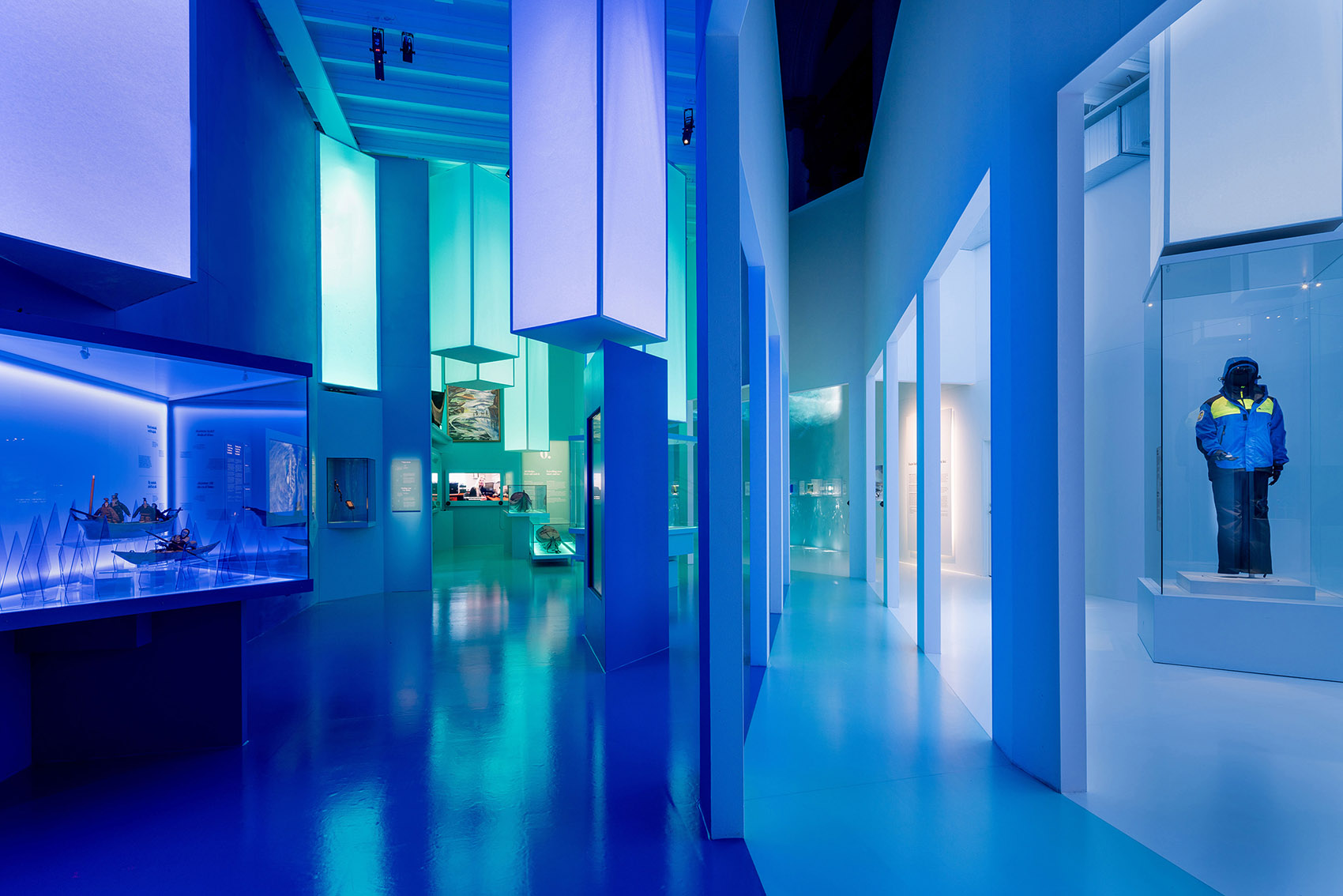
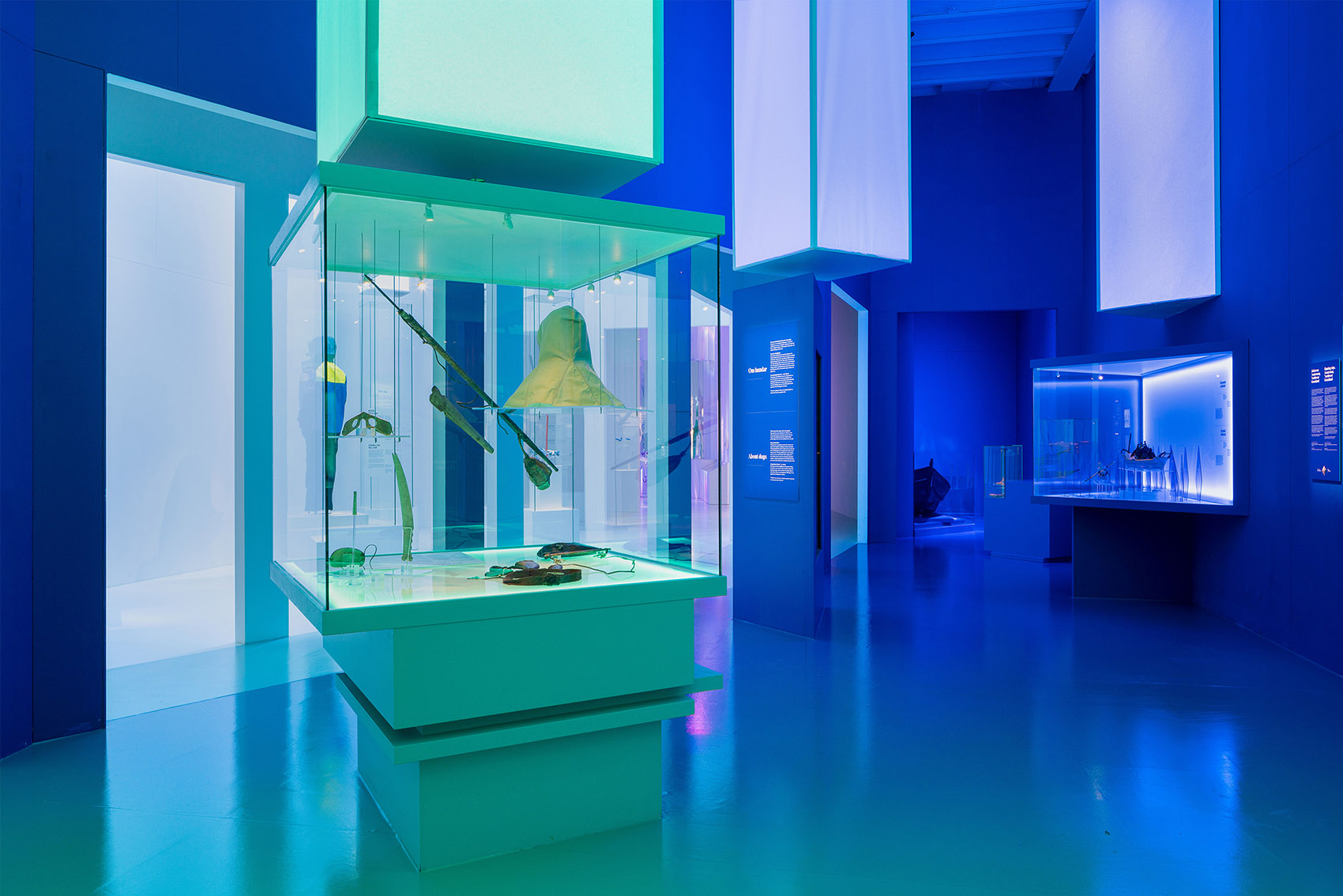
▼交通工具的演变,the evolution of transportation © Hendrik Zeitler
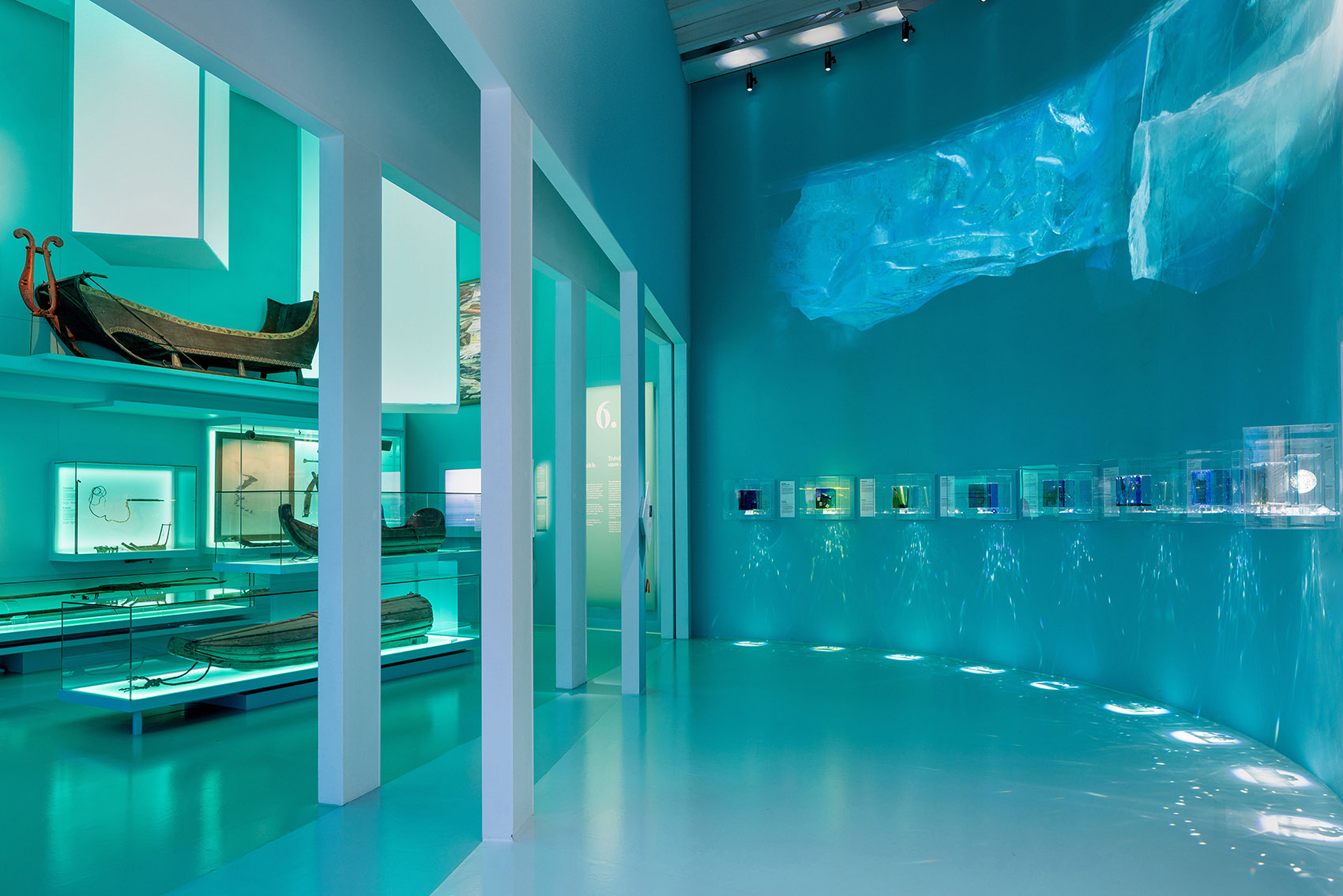
▼展品船只,the exhibits ships © Hendrik Zeitler
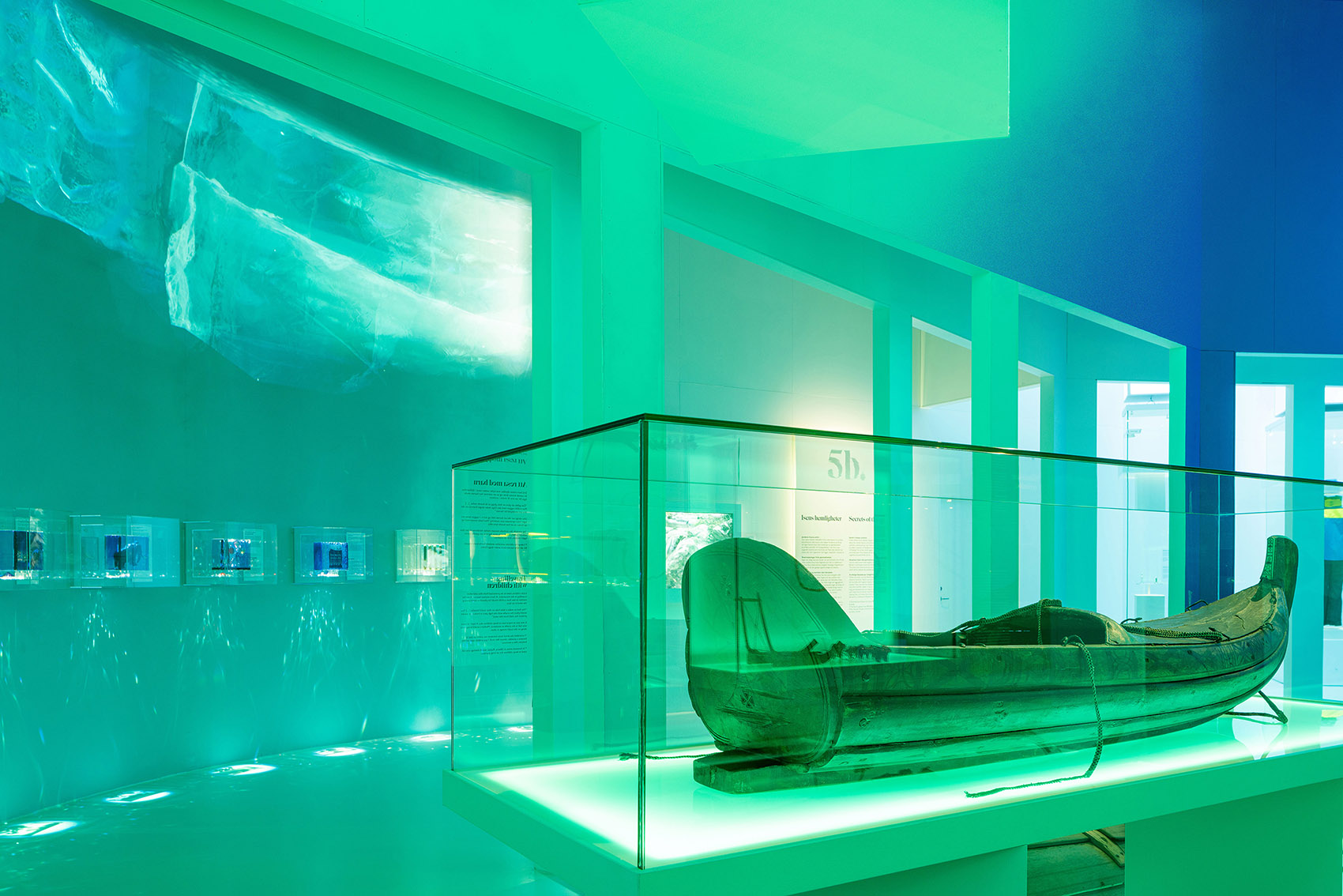
▼代表冰块完全融化后的深蓝海洋区域,it represents the deep blue ocean after the ice has completely melted © Hendrik Zeitler
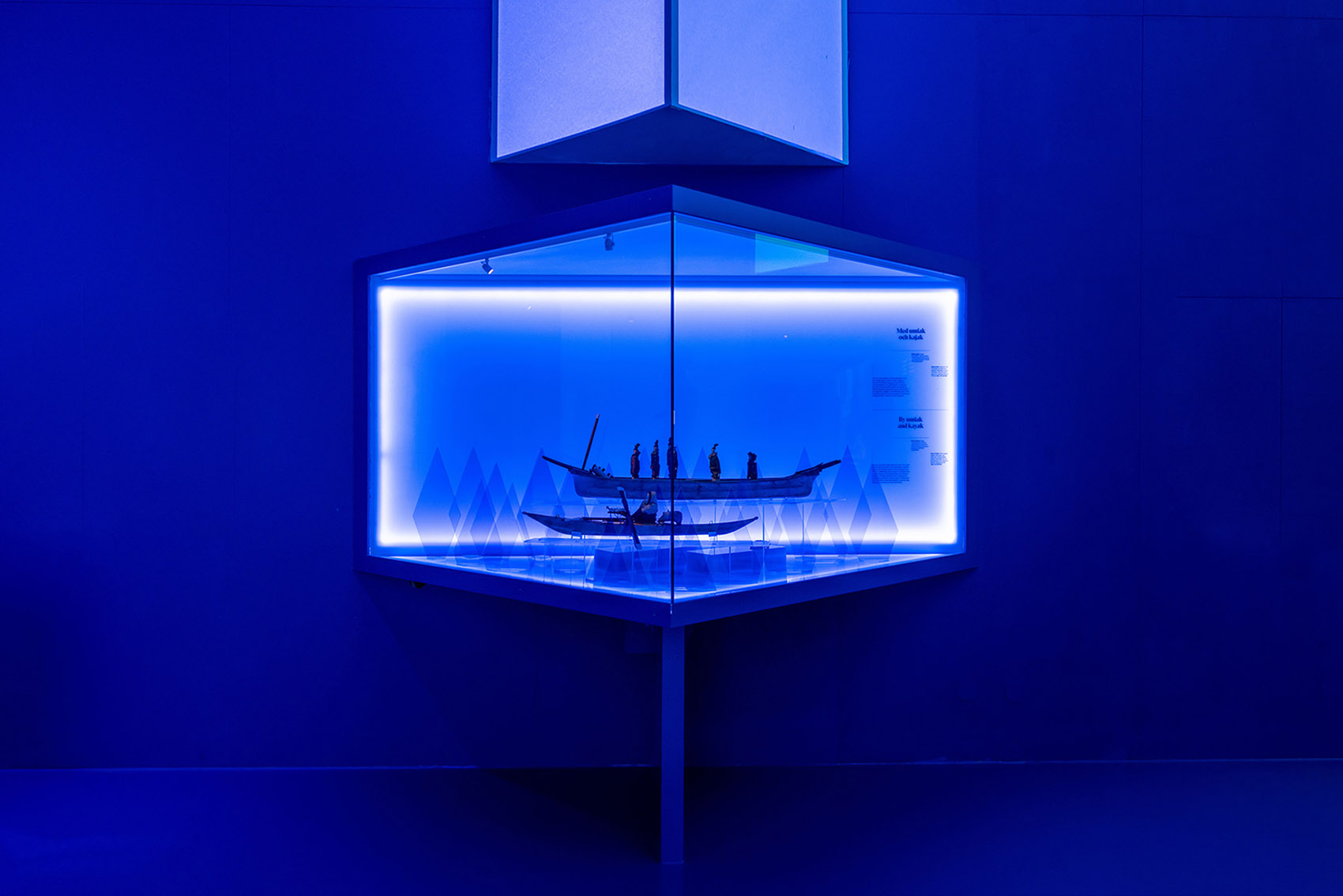
由于气候的变化,人们发现在由木头或混凝土制成的静态房屋里居住变得愈发困难。传统的帐篷在这里看起来似乎更加稳定,因为冻土的融化会导致土壤开裂,地面塌陷。在北极,木材一直是一种非常珍贵的材料,通常只能用作浮木或从国外进口。以大型纺织品为特色的帐篷区,灵感来自北极帐篷的圆形形式。相比之下,展览的静态房屋部分是由木头建造的,其灵感来自冰岛、法罗群岛、格陵兰岛和西伯利亚的三角形屋顶。
Due to climate change, people find it increasingly difficult to live in static houses made of wood or concrete. Here, traditional tents can be seen as more stable as the thawing permafrost can cause the soil to crack and ground to give way. In the Arctic, wood has historically been a very precious material as it could only be obtained as driftwood or imported from abroad. Large textiles characterise the tent areas. Here, inspiration comes from the round forms of the Arctic tents. In contrast, the section of the exhibition with static houses is built of wood and is inspired by the triangular rooflines in Iceland, the Faroe Islands, Greenland and Siberia.
▼以大型纺织品为特色的帐篷区以及由木头建造的静态房屋,tent areas featuring large textiles and static houses made of wood © Hendrik Zeitler
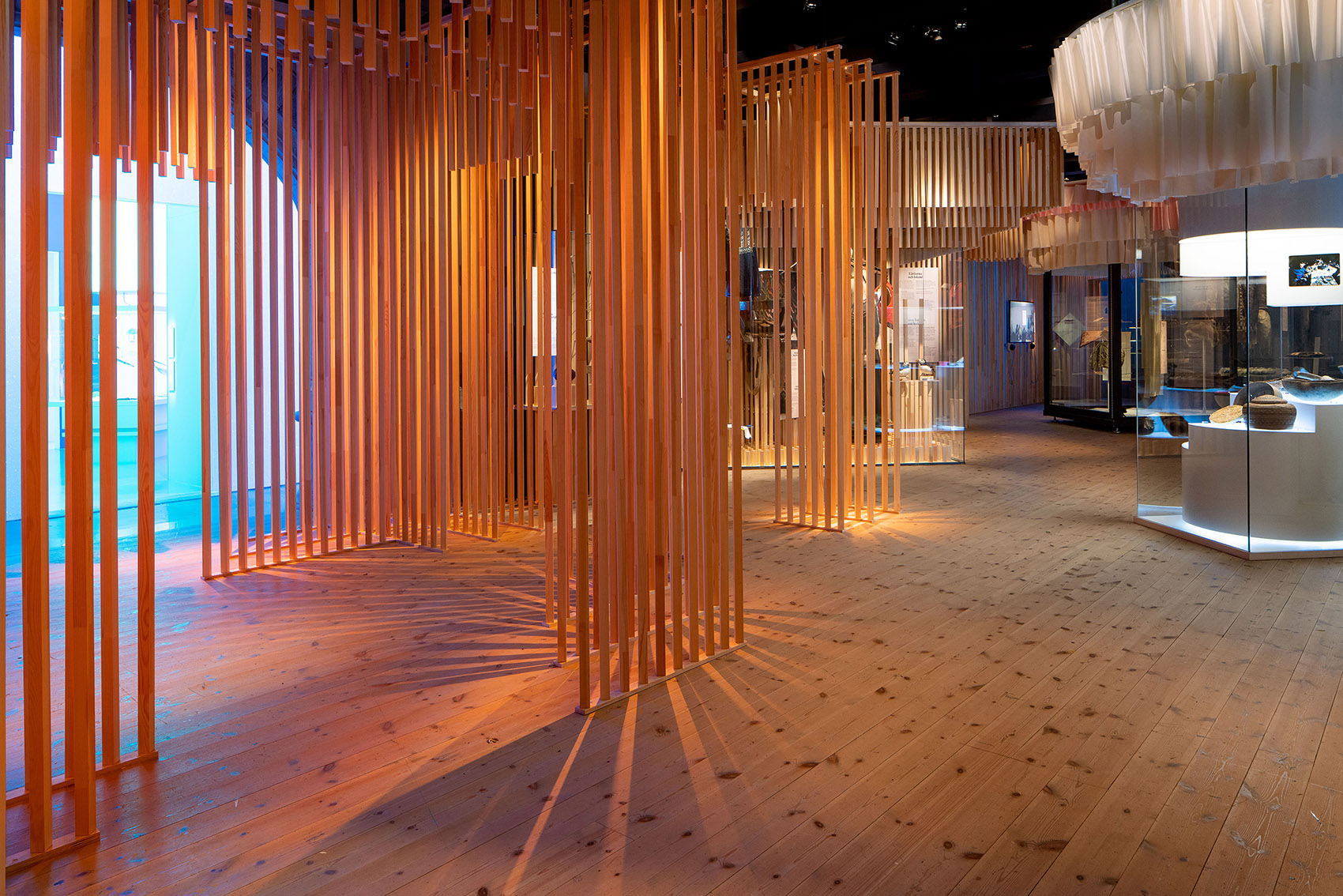

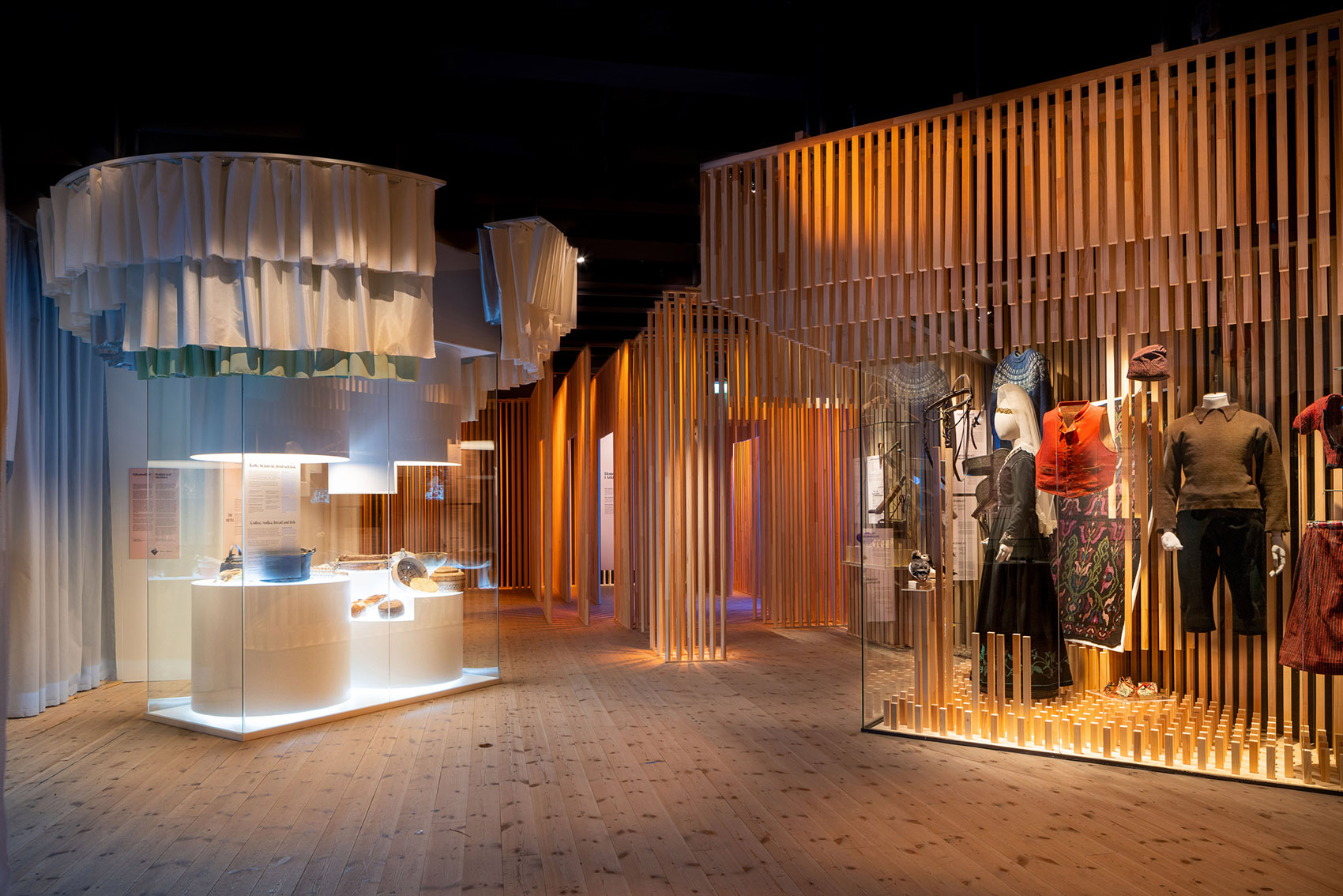
人类与资源和环境的关系也出现了裂痕。这样的裂痕还存在于小众的环保生活方式和大规模开采自然资源的工业生产之间。画廊采用干草等最环保的有机材料建造,与小众的生活方式形成共鸣。在展览的最后一部分,涉及大规模的资源开采。观众会进入一个巨大的石油管道中,当冰融化时,人们可以接触到以前无法获得的自然资源。一条新的裂缝也在那些环保人士和罔顾自然环境只为经济利益的人之间产生。
Cracks arise in how people relate to resources and the environment. Between the small-scale more circular way of life, where everything is valued and there is very little waste, and the large-scale industrial methods of extracting natural resources. The gallery is constructed using organic materials such as hay to resonate with the small-scale way of life. It is one of the most environmentally friendly building materials. In the last part of the exhibition, which concerns large-scale resource extraction, the visitor enters a section of a huge oil pipe. When the ice melts, people can reach previously inaccessible natural resources. A crack exists between those who protect the environment and those who want to exploit it for financial gain.
▼石油管道展厅,oil pipeline exhibition hall © Hendrik Zeitler
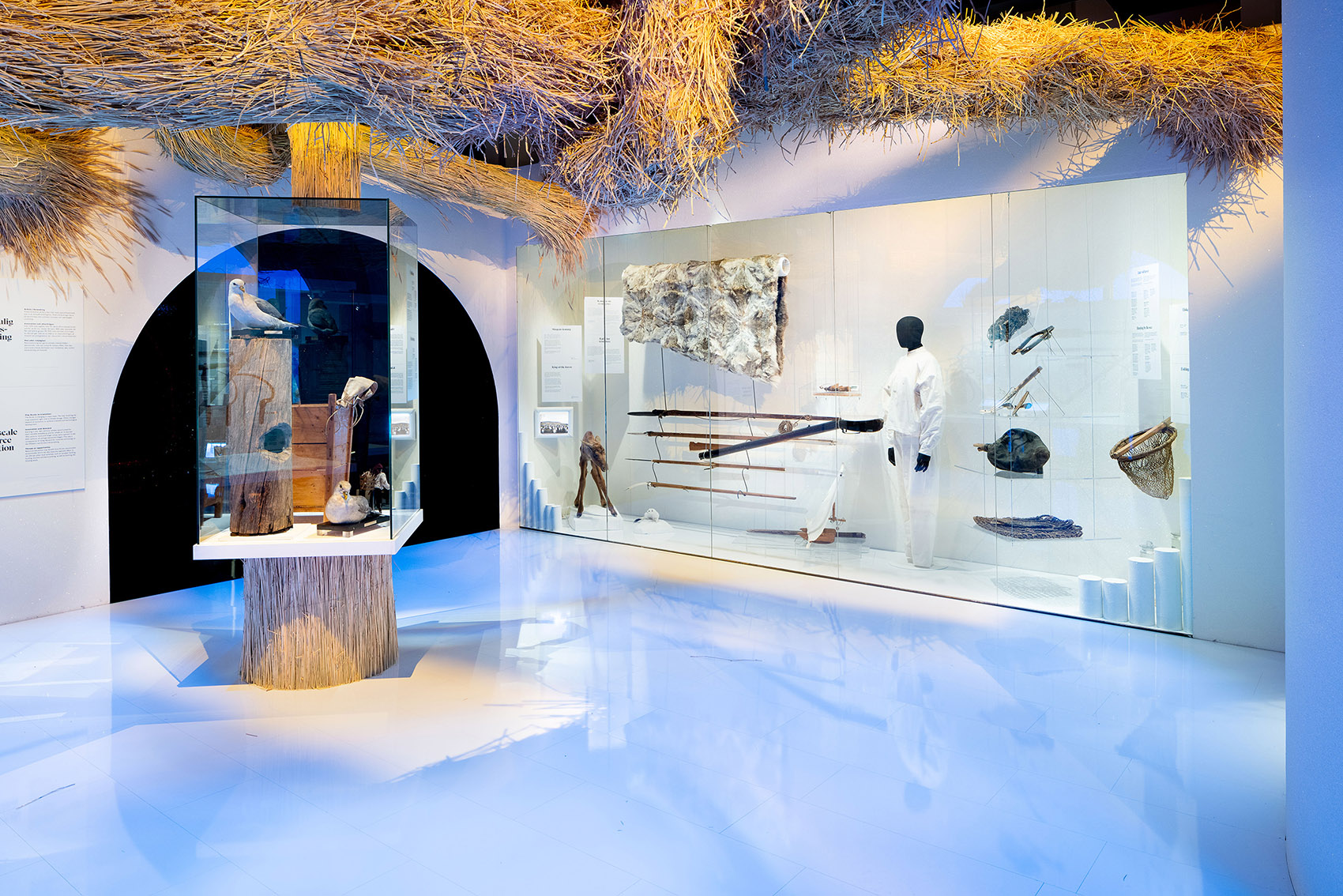
▼代表着人与环境关系的展品,exhibits representing the relationship between man and the environment © Hendrik Zeitler

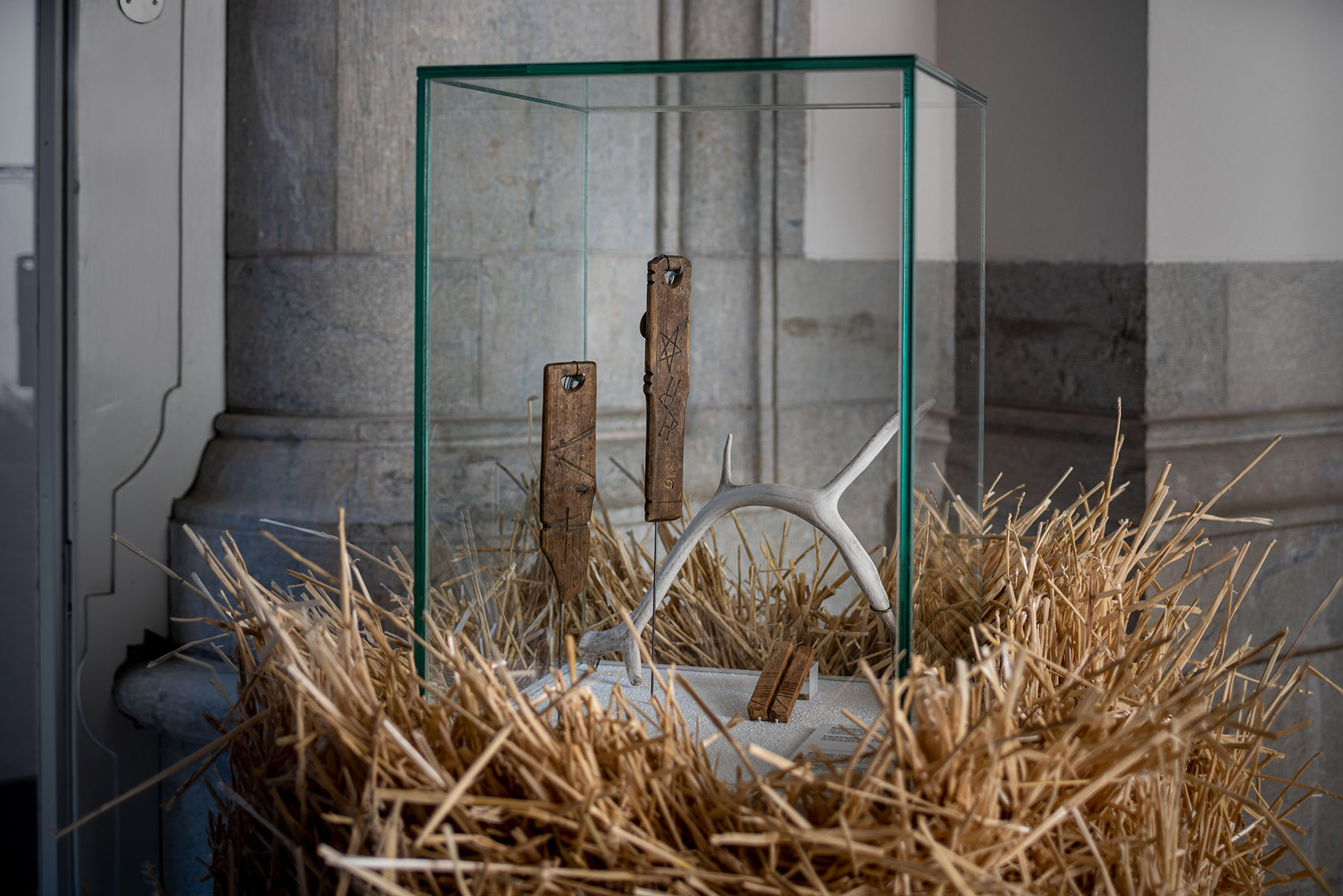
与此同时,裂缝还可以带来巨大的积极力量。裂缝是不容忽视的,它们可以使人们暂时忘掉起源和历史来进行倾听和交流;一起工作以弥合裂痕;一起创造新的生活,寻找更好的解决办法。
At the same time, cracks can bring about a tremendous positive force. Cracks cannot be ignored. They can make people listen and communicate, regardless of their origin or history. People can work together and heal cracks, and together, succeed in creating a new life, with new solutions.
▼博物馆大厅天顶细部,details of the ceiling of the museum hall © Hendrik Zeitler
